IN SERBIA











ĆUPRIJA
PARAĆIN, DESPOTOVAC
VELIKA PLANA,
SURDULICA,
The capital city of Serbia is a gateway between the East and the West. It is a melting pot of diverse cul tures and this has produced its characteristic spirit of openness and cosmopolitism. The two big rivers – the Sava and the Danube, and the multitude of cultural events and venues to go to leave a unique impression of the city. Belgrade has a great many interesting at tractions and a huge treasury of beautiful items in its museums, churches, streets and parks. Exciting and dynamic, Belgrade is a strong urban magnet.
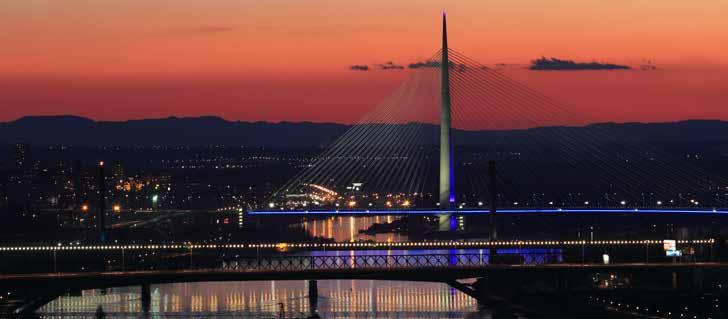
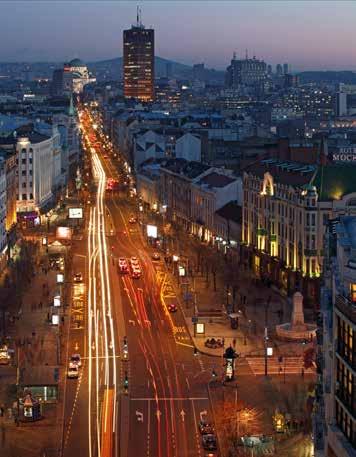
The Primeval Beginnings of the White City Belgrade Fortress and Kalemegdan Park are open-air museums of the history of the city. Within the walls of the fortress, there are a lot of monuments that bear testament to the development of the city from ancient times to today. In the Upper Town, you have the Statue of the Victor (Pobednik) – the symbol of the city, the Military Muse um, the Roman Well, Ružica Church, the Church of St. Petka and the Clock Tower. In the Lower Town, the exhibition in Nebojša Tower and the Belgrade Zoo are worth a visit.
The pedestrian zone and shopping area – Knez Mihailova Street (Uli ca Kneza Mihaila) and Republic Square (Trg Republike) – are amon gst the most architecturally valuable and liveliest parts of the city. The Prince Mihailo statue and the palace of the Serbian Academy of Sciences and Arts are two of the most recognisable features of the city centre. There are also the edifices of the National Theatre and the National Museum. The Ethnographic Museum, Princess Ljubica’s Residence, the Serbian Orthodox Church Museum, the Zepter Muse um, the Museum of Applied Art and the Gallery of Frescoes, as well as many other institutions of culture, are located here.
There is a saying: “He who has not been to Skadarlija has not visited Belgrade.” In that old, cobbled street, there are the famous kafana (traditional taverns): Tri šešira (Three Hats), Dva jelena (Two Deer), Ima dana (There’s Time) and Šešir moj (This Hat of Mine). They nu rture the traditional, joyful pastime of spending time listening to urban traditional folk music and savouring the national cuisine. A gentleman’s cane, a carnation and a boater hat are the symbols of the quarter.
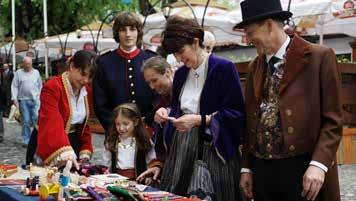
The city’s riverbank area is its special treasure: floating bars and nightclubs (called ‘splavs’), cafes, restaurants and green spaces. All these offer the visitor a unique impression of the metropolis on the water. The quay at Ušće (the confluence of the two rivers), Zemun Quay and the Sava River Dock are only a small part of what’s on offer at the river banks: tourist sightseeing of the city from the rivers, a night out in one of floating clubs, riding a bike or taking a stroll and admiring the bridges.
One of the largest Orthodox temples in the world was built on the spacious plateau in Vračar where the Turks burnt the relics of St. Sava, the first Serbian archbishop and one of the greats of the nati onal history, in the late 16th century.
Once located on the very border of two empires, Zemun still exudes the atmosphere of the Austrian-Hungarian Empire today. The Gardoš Tower, offering a panoramic view of the Danube, is the symbol of this extraordinary town. Taking a walking tour of the beautiful buildings here also includes a stroll along the lively and beautifully landscaped bank of the Danube.
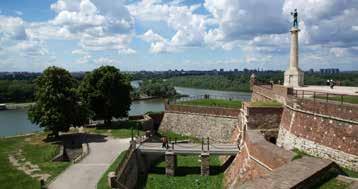
The Royal Palace and the White Palace are a testament to the history and refined artistic feel of the Serbian Karađorđević dynasty. Today, Crown Prince Alexander II lives in the Royal Palace, a showcase villa built in Serbo-Byzantine style.
The royal park, the royal church and the oriental residence of the great Serbian ruler Miloš Obrenović tell the story of the history of the liberation of Serbia from the Turks. A magnificent old plane tree is the prominent feature.
The Archive of Nikola Tesla, a scientific genius who “lit up the planet”, is inscribed on the UNESCO Memory of the World Register. Items from the scientist’s legacy are on display in the Nikola Tesla Museum. The uniquely illustrated and the oldest Cyrillic manu script, the Miroslav’s Gospel (12th century), which is kept in the National Museum in Belgrade, is yet another precious item from the list. The Historical Archive of Serbia contains another world treasure: the telegram of the declaration of the First World War.
One of the brightest chapters in European prehistory was written no more than fifteen kilometres or so from Belgrade – in today’s settlement of Vinča. In the archaeological park, in the form of a hillock next to the River Danube, one can see with the naked eye the layers of settlement built up over eight millennia. The most valuable of the exhibits, including the famous figurine of the Lady of Vinča, are on display in the museum.
Momo Kapor, a legendary chronicler of the spirit of the city, called Belgrade a low-cost New York. The food available in the city comprises dishes from cuisines from all over the world, and the city is known as the “crowned” capital of entertainment.

Known locally as the ‘Belgrade sea’, Ada Ciganlija is a beautiful lake surrounded by woodlands, cafes, restaurants and bike paths. It is home to the most beautiful recreational area of the city where visi tors can enjoy swimming, water sports and sailing. Ada also offers a spectacular view of the newly-built Ada Bridge, a new focal point and landmark for the city.
The Tower of Avala, located on the mountain of the same name, is yet another symbol of the city, as a testament to Belgrade rising from the ashes. Destroyed in the NATO bombing of Yugoslavia in 1999, the tower was later rebuilt. The belvedere on the top of the tower offers an impressive panoramic view. Atop Avala mountain there is also the Monument to the Unknown Hero.
More information about visiting the museums and sacral heri tage can be found at: www.tob.rs/sr-lat/see
The many cultural, sporting, entertainment and tourism events and festivals in the city are announced on the following website: www.tob.rs/belgrades-events
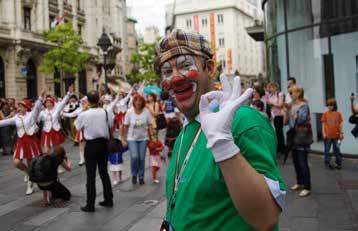
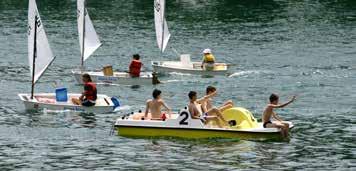

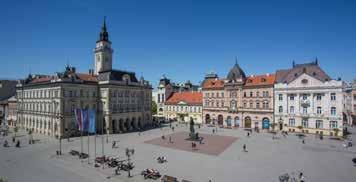
A visitor’s first impression of Novi Sad is that it is a city of well-tended beauty. Its architecture and spirit have been shaped by many nations. Its relaxed vibe and position, surrounded by fertile lowland, Fruška Gora mountain and the Danube, makes the capital city of Vojvodina a pearl among the Serbian cities. It is also known as the ‘Serbian Athens’, the European Youth Capital 2019, the European Capital of Culture 2021 and as the home of EXIT Festival.
The Petrovaradin Fortress, the ‘Gibraltar on the Danube’, with its monumental architecture, underground military galleries and won derous labyrinths, is one of the symbols of the city. The Clock Tower plateau offers a panoramic view of the city and the powerful river below. The City Museum, the Planetarium and a series of art studios are located within the complex.

The Lower Town of the Fortress, with its narrow streets and baroque edifices, offers a very different atmosphere. The sights here include the Church of St. Juraj, the Church of St. Paul, the Belgrade Gate, the Church of St. Peter and Paul, the Magistrat building (former town ad ministration building), the Military Hospital and the house where Ban Jelačić was born.
This square in the city centre is dominated by the buildings of the City Hall and the Roman Catholic Church of the Name of Mary (known as ‘The Cathedral’ by the locals) as well as the monumental statue of Svetozar Miletić. In the churchyard, there is the beautiful Plebanija building (Parish Office) and the city’s Cultural Centre.
The streets of Zmaj Jovina and Dunavska, with their colourful houses and palaces and a network of side streets and passages, constitute the most picturesque part of the pedestrian zone. Here we also have the Bishop’s Palace (Vladičanski dvor), the Orthodox Cathedral Church of St. George and Zmaj Jova High School. Dunavska street leads to a green oasis in the city, Dunavski Park. On the very edge of the park, there is the fantastic Museum of Vojvodina. The Museum of Contem porary Art and Permanent Natural History Exhibition are also nearby.
On this square named after the great benefactress Marija Popović Trandafil stands her endowment, a building that serves as the prin cipal seat of Matica Srpska, the oldest Serbian cultural institution. Matica Srpska is home to three million books, manuscripts, chroni cles, collections of works and an extraordinary collection of portraits of famous citizens, including a portrait of Marija Trandafil herself. The famous St. Nicholas (Nikolajevska) and Almaš churches are in the im mediate vicinity.
You can find three precious gems of the city right next to one anoth er on the small ‘Gallery Square’: the Matica Srpska Gallery, the Pavle Beljanski Memorial Collection and the Rajko Mamuzić Gift Collec tion. The Matica Srpska Gallery displays national art dating from the 16th to the 20th centuries. Pavle Beljanski, a diplomat and passion ate art collector, gifted the nation one of the most significant col lections of Serbian paintings from the first half of the 20th century, and collector Rajko Mamuzić gifted the works of the first post-war generation of artists.
The magnificent Synagogue that stands here serves to remind us of the large Jewish community which tragically died in the Second World War. Today, the Synagogue is an elite city concert hall. Special tours designed to familiarise tourists with the rich Jewish heritage of Novi Sad are available.

This street lined with cafes and clubs, which is named after the great Serbian actor Laza Telečki, has become a synonym for a good time. The ‘L.T. Zone’ is a popular meeting place where people flock to ex perience the city’s buzzing nightlife.
The city takes great pride in its Štrand, a sandy river beach with a view of the Freedom Bridge. Beyond the beach lies the green oasis of Ribarsko Ostrvo (Fishermens’ Island) which is where those who enjoy fishing and sailing come. The urban part of the bank is the quay with a view of the Fortress. Here you can find one of the symbols of the city, the ‘Family’ monument, dedicated to the memory of those killed in the mass killings during the Second World War.
Fruška Gora National Park is a favourite place to escape the hustle and bustle of the city. Although most of the monasteries on Fruška Gora are situated on the territories of other municipalities, Novi Sad is the centre from where to take sightseeing tours of the ‘Serbian Mount Athos’. On the northern slopes of the National Park, the nearby mon asteries of Beočin and Rakovac, as well as a monastery in the territory of the town of Kovilj, are worth visiting.
Apart from a broad offer of international dining, the gastronomical ‘story’ of the region of Bačka is connected to the Danube csarda restaurants and salaš farms. At old-style csarda restaurants, river fish and fish soups are available. On the farms, the hearty Bačka lunch is savoured slowly as a relaxed affair. The wide choice of wines produced on the winegrowing hills of Fruška Gora, the fruit brandies (called rakija in Serbian) and the music by the tamburitza players all go well with the lunch.
• Novi Sad Music Festivals – NOMUS, April
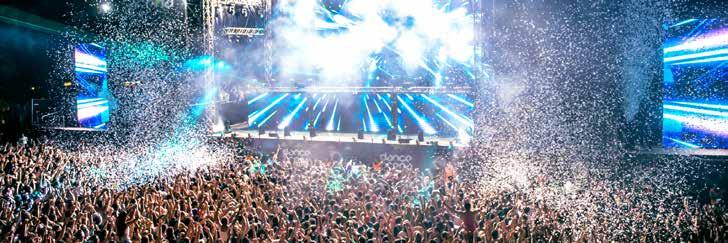
• Sterijino Pozorje Festival, May-June, Serbian National Theatre
• EXIT Music Festival, July, Petrovaradin Fortress
• Cinema City – International Film Festival, August–September
• Gradić Fest, September
• Futog Cabbage Festival - Kupusijada, November, Futog
Tourist Organisation of Novi Sad www.novisad.travel
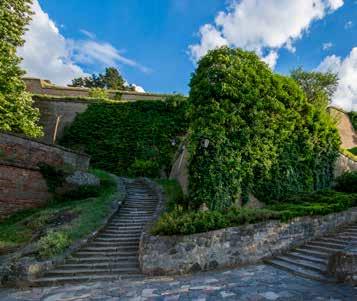

• The Patriarch’s Palace and the Orthodox Cathedral Church
• The Karlovci High School, the oldest in Serbia
• The Four Lions Fountain and the Chapel of Peace
• The “Živanović” Family Museum of Beekeeping
• A glass of Bermet or Riesling
• Kugelhupf (kuglof) cake, white coffee and honey
• Fish specialities at the old-style csarda restaurants on the Danube
A great of Serbian poetry, poet Branko Radičević, who died young, was buried in Stražilovo, a favourite picnic spot today. Each au tumn, Branko’s tomb and monument are visited by those taking part in the “Branko’s Kolo” (folk circle dance) poetry event.

Bermet, dessert wine prepared with medicinal herbs and aro matic spices, is the trademark of Karlovci. The Viennese Court had bermet on the dining table and winegrowers from Karlovci were spared compulsory military service because of the quality of their wines.
The medieval British custom of noblemen being seated at a round table, in the history of global diplomacy, was first practiced right here in Karlovci, where, after long negotiations between the war ring parties, the decisive Treaty of Karlowitz was signed in 1699 in the Chapel of the Lady of Peace.
The ethno house in Maradik is about 150 years old. Walking through the authentic collection of ethnic items, visitors can learn a great deal about the life people lived in that part of Srem.
• Sailing the Danube from Čortanovci to the confluence of the Tisa
• Visiting the wine cellars of Sremski Karlovci
• Visiting the Danube csarda restaurants and salaš farms
• A bike ride along the EuroVelo 6 cycling route
• Hiking or taking a jeep tour on Fruška Gora mountain
• Eco excursion to Krčedinska Ada island
• Kugelhupf Cake Festival, June
Grape picking in Karlovci, September-October
Scena Fest, July, Inđija
Days of Vojvodina-Bavarian Culture – Beška Fest, September
Organisation
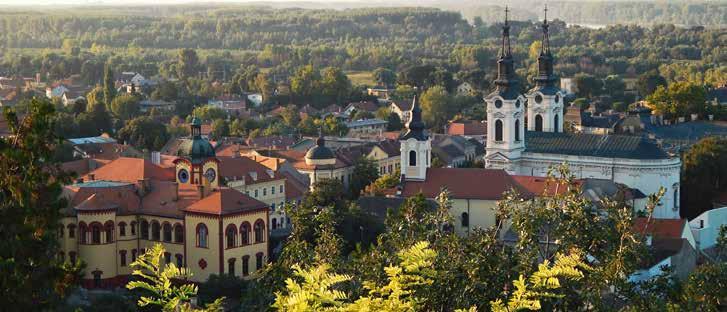

• Fish specialities served in the old-style csarda restaurants in Bač
• Petrovac kulen (paprika-seasoned sausage) with cherry compote
• Organic juices from Selenča
• A bike ride along the EuroVelo 6 route and on local paths
• A weekend at the Petroland Aqua Park
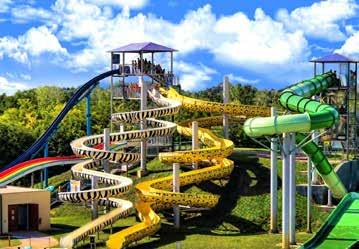
• Horse riding and hunting pheasants in Karađorđevo
• Old craft workshops at Didina House and the Ahoj Centre
• Bathing and recreation on the famous beaches of Bačka Palanka
• Bathing on the beaches of Lake Provala near Bač
• Kulen Festival, May, Bački Petrovac
• Weddings – Past and Present, International Festival of Wedding Customs, July, Kulpin
• Bač Fortress with an exhibition
• Franciscan Monastery
• Bođani Orthodox Monastery
• Palace and the Agricultural Museum, Kulpin
• Dunđerski Palace and Park, Čelarevo
• Museum of Vojvodina’s Slovaks, Bački Petrovac
Today, the large area of the Pannonian Plain is known as Bačka, after the famous medieval fortress of the same name. This for tress was erected on a river island by Hungarian King Robert (14th century). It was a powerful ecclesiastical and military foothold, home to kings and noblemen. The symbol of Bač is its dungeon tower which offers an impressive panoramic view.
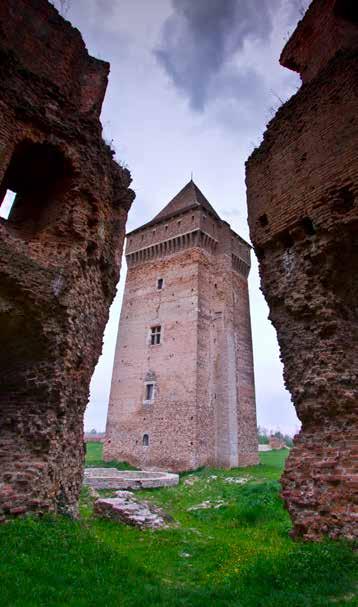
The Palace in Kulpin belonged to the famous, noble Stratimirović family. Later, their estate came into the possession of the Dunđerski family. Today, the palace is an exhibition gallery, with the Museum of Agriculture in the barnyard. The Dunđerski family also had a palace in nearby Čelarevo.

The paprika-flavoured Petrovac kulen (Petrovská klobása) is also known as the ‘dragon’s sausage’ given its hot and spicy taste. The secret recipe was passed down from one generation to the next, and more recently, it received protected designation of geographical origin.
Tourist Organisation of Bački Petrovac www.turizambackipetrovac.rs
Tourist Organisation of Bačka Palanka www.toobap.rs
• The symbol of Subotica – the secessionist Town Hall
• The extraordinarily beautiful Synagogue and the Raichle Palace

• The symbol of Palić – the Park and the Water Tower
• Palić Lake and the Zoo

• The Town Hall and the Firefighters’ Station in Senta
• The House of Old Crafts in Senta
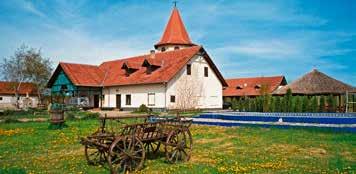
• Veal pörkölt stew with flat noodles and krompiračа potato pie
• Wines from the sands and fruit brandies (rakija)
• Senta marzipan
• Water sports and cycling around Palić
• Ecological tour of Ludaš Lake
• Riding Lippizaner horses at Kelebija Horse Stable
• The wellness programme in Kanjiža Spa
• Visiting wine cellars and salaš farms
• European Film Festival, July, Palić
• The “Dužijanca” Celebration of the End of the Harvest, end of August, Subotica
• Flower of the Tisa Festival, June, Senta
Every June, the Tisa river is covered in clouds of whitish butter flies. The ‘Flower of the Tisa’ is a very old and rare species of the river butterfly, which spends its short ‘wedding flight’ fluttering just above the river surface. One can enjoy watching this unusual phenomenon from the promenade that stretches along the Tisa river.
Memorial Observation Deck of the Battle of Senta In the tower of the Town Hall in Senta, in remembrance of the cru cial battle fought between the Ottoman Empire and the Habsburg Monarchy (1697), visitors can see a scale model demonstrating the battle of Senta with 2,000 figures, historical documents and military equipment. The view of the town and its surroundings from this vantagepoint is unforgettable.
Kanjiža Spa came about thanks to shepherds who accidentally discovered hot medicinal water while digging a well. Today, the spa is a modern centre for rehabilitation and recreation.
INFO
Tourist Organisation of Subotica www.visitsubotica.rs
Park Palić www.park-palic.rs Park prirode Palić www.palic-ludas.rs
Tourist Organisation of Kanjiža www.visitkanjiza.rs
Toruist Organisation of Senta www.sentainfo.org
• The Županija (County Hall) building and the monumental “Battle of Senta” oil painting on canvas
• Main street, Town Hall and the “Somborski venac”
• Town Museum and Museum of the Battle of Batina, Bezdan
• Milan Konjović Gallery
• Old Crafts Routes: Bački Monoštor and Telečka
• The building of the oldest Serbian brewery in Apatin
• Fish paprikash with flat noodles
• Marinated, smoked river fish
• A pint of Apatinsko beer
• Riding in a fijaker (horse-drawn carriage) around Sombor and listening to the music of tamburitza players
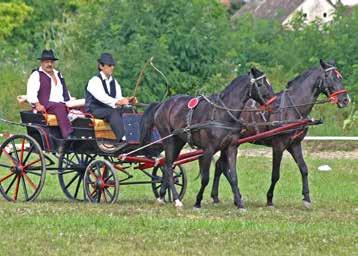
• Visiting the Sombor salaš farms and csarda restaurants
• Navigating the Great Bačka Canal
• Visiting the Gornje Podunavlje Special Nature Reserve
• Rest and recreation at Spa Junaković
• Sombor Theatre Marathon, June
• Sombor Pot Cooking Event, June
• The Fishermen’s Nights of Apatin, July
TID – Canoe Regatta, Apatin Marina, July
Wizard of the Serbian Language Laza Kostić, a great of the romanticism period, is considered the most famous resident of Sombor. In this town he wrote Santa Ma ria della Salute – one of the most beautiful Serbian love poems. He was an extraordinarily gifted writer, a renaissance-educated man. Part of his legacy is on display in the Town Museum.
Artist of Fire and Sun Milan Konjović dedicated his whole life to painting and left over 6,000 works of art behind him. He was a painter of the elusive plains of his native land: Konjović is to Vojvodina and Bačka what Van Gogh is to southern France and Gauguin is to Tahiti. He left an outstanding collection to his beloved town and it is on display in the gallery named after him.
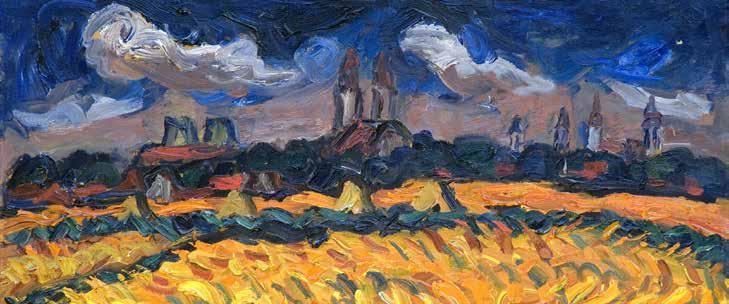
The Gornje Podunavlje Special Nature Reserve is an ‘island’ of protected nature. It is home to the white-tailed eagle, the larg est in Europe, and the rare black stork. This area, with more than 280 species of birds, is an ideal place for nature lovers and bird watchers.
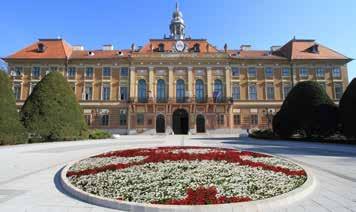

• Castle of Pal Kray – today’s Town Museum, Bačka Topola
• The grandiose Cathedral of the Virgin Mary, Bačka Topola
• The Native ‘Pannonian’ House, Bačka Topola

• The Cartwright’s and Blacksmith’s Workshop, and the Museum of Milling
• The Church of the Holy Epiphany, Srbobran
• The Church of the Exaltation of the Holy Cross, Srbobran
• Turija sausages
• Cherry brandy and Feketić wines
• Game specialities
• Horse riding in Zobnatica
• Visiting the autochthonous salaš farms in the region of Srbobran
• The educational contents of the Katai Salaš farm in Mali Iđoš
• Hunting rabbits, pheasants and game in rich hunting grounds
• Fishing
• The “Kobasicijada” Sausage Festival, February, Turija
• Domboš Fest, July, Mali Iđoš
• Zobnatica Equestrian Games, September

The Zobnatica horse breeding stable has a tradition longer than two centuries. The complex is home to the unique exhibition of the Horse Breeding and Equestrian Sport Museum, whose inte rior is in the shape of a horseshoe. Zobnatica also has a modern hippodrome.
The baroque Castle of Baron Kray Pal is the location of the Home land Museum of Bačka Topola today. An imposing cathedral, the second tallest in Europe, was built on his estate. The baron died in Pest as an artillery general, and his heart was brought from the battlefield in a silver box and buried in the Cathedral.
The “Pannonia” Palace near Bajša (1846) was built by Count Ar pad Falcione. Today, it is a museum with authentic style furniture. A spacious, well-tended park surrounds the building.
Tourist Organisation of Bačka Topola www.backatopola.org.rs
Tourist Organisation of Mali Iđoš www.tourism-mi.org.rs Centre for Sport and Tourism of Srbobran www.cst.org.rs
IN A
• The symbol of Vrbas – the Evangelical and Reformed Churches
• Exhibition: Secret Headquarters of the Antifascists “Bapa’s Base”
• The Church of the Presentation of the Blessed Virgin Mary and the “Water” Chapel
• Industrialists’ old villas
• The “Bapina Baza” (Bapa’s Base) Ethno House
• The Neolithic Red-haired Goddess, Odžaci, a collection of archaeological findings

• The Sečen Palace and Old Park, Temerin
• Ethno-Park “Brvnara”, Bački Jarak
• The Lock and the Mill in Mali Stapar
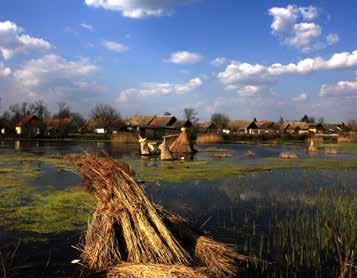
• Chicken and fish paprikash
• Fish soup
in a
• Russyn specialities in
Krstur
• Cycling the EuroVelo 6 route
• Recreational activities in Jegrička Nature Park
• Temerin Wine Routes
• Bathing in the Temerin
Tourist Organisation of Vrbas www.turizamvrbas.com
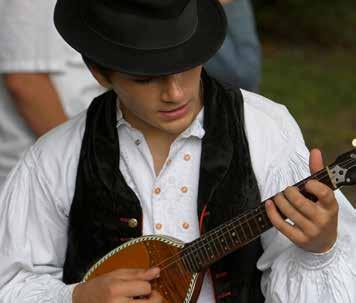
Tourist Organisation of Kula www.turizamkula.rs
Tourist Organisation of Odžaci www.turizamodzaci.rs
Tourist Organisation of Temerin www.temerintourism.org.rs
In the centre of Vrbas, a monument was erected in honour of Jozsef Kiss, the “noble Hungarian” who built the Great Bačka Canal (18th century). A feat of engineering and construction, the works transformed the marshes into fertile arable land. The canal was dug by hand and is 118 kilometres long.
The history of Odžaci is incomplete without mentioning hemp. The person who initiated the growing of hemp was Baron Kotman (18th century). Thanks to the enterprising Baron, Odžaci became the capital of hemp, and its fame was also spread by the British Navy.
The Jegrička river is a small river of 64 kilometres in length. The Nature Park spreads along its banks, and includes Bačka Palanka, Vrbas, Temerin and Žabalj. The Park’s Info Centre is located in Te merin and catamaran rides, fitness trails and birdwatching are on offer. Another of the beautiful sights is the Windmill in Ravno Selo, which is surrounded by a beautiful botanical garden.
There were guilds of tailors, shoemakers and weavers in the town of Kula as early as the beginning of the 19th century. The town was for a long time known for its hat factory, and the history of the sugar factory is steeped in tradition.
• The town centre and National Museum, Kikinda
• The “Terra” Terracotta Sculpture Museum
• The horse-powered dry mill – Stara Suvača
• The buildings on Bečej square and the Church of St. George
• Novi Bečej Museum – The Glavaš House

• Arača – medieval church ruin, Novi Bečej
• The “Kotarka” Museum and the Žeravica Agricultural Machinery Museum
• Eiffel’s Lock in Bečej
• Pumpkin pie
• White bread, pastries and strudels
• Goose specialities and chicken paprikash
• Wine made with the Muscat Croquant grape variety from Biserno Ostrvo island
• A weekend at the “Fantast” Palace and horse riding
• A boat ride on the Tisa river, the Old Tisa and canals
• Birdwatching in Kikinda – the largest wintering area of eagle-owls in the world
• Birdwatching in Slano Kopovo – the migratory habitat of cranes
• Cycling, carriage riding and horse riding on maintained paths
• Pumpkin Days, September, Kikinda
• The Assumption Days, music and food event, August, New Bečej
• Easter Egg Tapping, Mokrin
• Tanderbal – a festival on the Tisa, August, Bečej
Bogdan Dunđerski, a large estate owner and horse lover, made his dreams come true by erecting a building that looks like it came straight out of a fairy tale. He was a friend of the famous painter Uroš Predić, who painted the valuable iconostasis of the palace chapel. Today, it is a luxurious hotel – the Fantast Hotel, with horse stables.
The history of art recalls few examples of the creation of large terracotta sculptures. Only after the start of the Terra Internation al Symposium were monumental sculptures created again using the primordial material – clay. The Museum displays an impres sive collection of more than 1,000 sculptures by artists from all over the world.

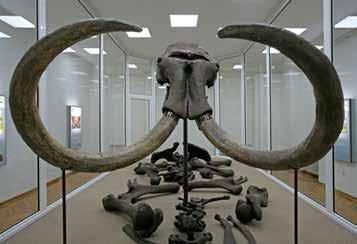
In the clay pit of a roof tiles factory, a huge skeleton of a mam moth, dating more than 500,000 years, was found. The mam moth of Kikinda was named Kika and is a unique tourist at traction. An original-size replica is exhibited in the museum grounds.
Tourism Office of the Town of Kikinda www.kikinda-turizam.rs
Tourist Organisation of Bečej www.tobecej.rs
Tourist Organisation of New Bečej novi-becej.travel
• The Town Hall and the Gradska Bašta park
• The Cathedral of St. John of Nepomuk
• The building of and exhibition at the National Museum of Zrenjanin
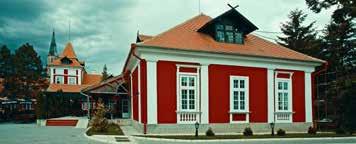
• The pedestrian zone, the town palaces and bridges over the Begej river
• The Church of St. Nicholas in Žabalj
• A sweet morsel: gomboce dumplings and šnenokle (floating island dessert)
• The Banat “slow” lunch accompanied by tamburitza players
The River that Gave Shape to the Town Zrenjanin, once known as Veliki Bečkerek, the seat of the prosper ous Torontál County, is a town of extraordinary urban imagination: the winding meanders of the Begej river were the basis for the for mation of the town streets. The old core and the pedestrian zone comprise of a set of attractive buildings, erected for the most part during the 19th century and at the beginning of the last century.
With great pomp, Lazar Agoston opened his hunting castle in 1820. At the ball organised for aristocrats of Vienna and Pest, Franz Liszt – a child prodigy at the time – played. Hungarian and Serbian heirs-to-the-throne used to come to the Castle to go hunting there. Today, the hunting castle is an exclusive hotel.
The Rusanda Spa became famous for its therapeutic mineral mud which today, as it was in the olden days, is taken from the lake by hand. The Spa has been in operation for more than 130 years thanks to the village priest who found a cure for his gout in the lake’s sludge.
The big loess plateau of Titel Hill (Titelski breg) is an exceptional phenomenon of this kind in Central Europe. Legend says that At tila the Hun, together with his priceless treasure, was buried be neath Titel Hill, somewhere in the bed of the Tisa river.
• A weekend at the Kaštel Ečka hunting castle
• Wellness programme and a walk in the woods at Spa Rusanda
• An eco-safari in the “Stari Begej – Carska bara” Nature Reserve
• Visiting the “Tiganjica” ethno-complex
• High-class golf on the courses in Žabalj

• Visiting the “Titelski breg” Special Nature Reserve
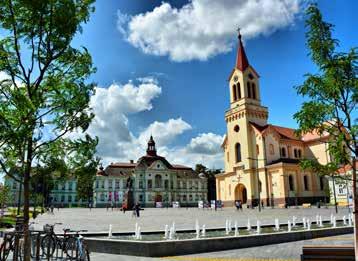
The great industrialist and benefactor Georg Weifert had a firmly held principle: “We must give in order to regain”. In his hometown of Pančevo, he erected the Church of Ana and a building in the Catholic cemetery. The Weifert Brewery, the Red Warehouse, and the two lighthouses at the confluence of the Tamiš and Danube rivers are part of the valuable industrial heritage of the town.
A series of scenes from legendary local films such as “Who’s Sing ing Over There?” and “The Marathon Family”, as well as some for eign films, were shot in Pančevo. The streets, squares, industrial plants, interiors of public and private houses faithfully evoke the ambiance of bygone times.
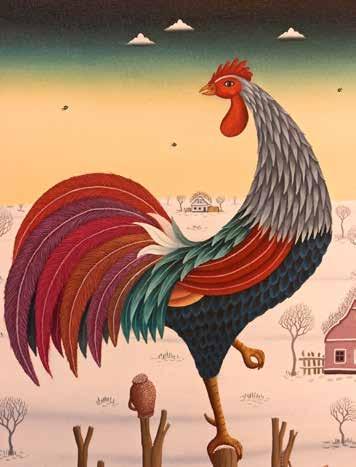
• The old town centre and the Pančevo National Museum
• The Monastery and Church of St. Carlo Borromeo
• The Church and Treasury of the Holy Transfiguration
• Vojlovica Monastery
• Georg Weifert Brewery Museum

• Mihajlo Pupin’s birth house, Idvor
• Banat bacon and Pančevo beer
• Fish specialities on the Tamiš river quay
• Specialities of Slovakian and Romanian cuisine
• Cycle paths to the Ponjavica Nature Park
• Horse riding and carriage riding at the Starčevac Equestrian Club and the Veličković Stud Farm
• Sport fishing on the lakes of Debeljača
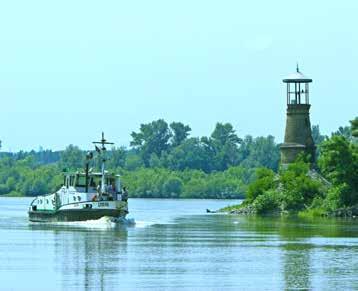
• Horse riding at the “Sto topola” centre in Crepaja
• Wellness weekend at the Relax tourist resort in Kovačica
• Days of Weifert, June, Pančevo
• October in Kovačica
Kovačica is a small Slovakian settlement with international fame. The most representative paintings are on display in the Gallery of Naïve Art and the Memorial House of Painter Martin Jonaš. The workshop where violins used to be produced and the naïve art gallery in the nearby Romanian village of Uzdin are also worth visiting.
World renowned physicist Mihajlo Pupin, the inventor of wire less telegraphy and telephony, was born in Idvor. He got the idea for his epochal invention from the way shepherds communicated with one another: they sent signals using a knife stuck in the ground.
Tourist Organisation of Pančevo www.pancevo.info
Tourist Organisation of Kovačica www.took.org.rs
• The town centre and “Konkordija” Town Museum
• The Bishop’s Palace (Vladičanski dvor) – the residence of the Bishop
• The Cathedral of St. Gerhard
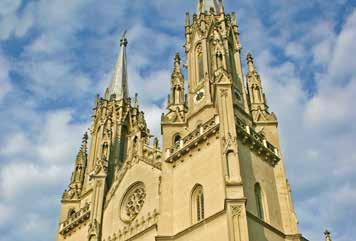
• The “Pharmacy on the Stairs” Museum and Paja Jovanović’s paintings
• Exhibition in Vršac Castle
• Visiting the town centre of Bela Crkva and the Tri Krsta (‘Three Crosses’) viewpoint
• Wine tasting at the wine cellars in Vršac
• Lunch “with a view” of Vršac Hill
• Bela Crkva fruit brandies (rakija)
• Mountaineering and mountain biking in the Vršac mountains
• Diving and sailing on the lakes of Bela Crkva
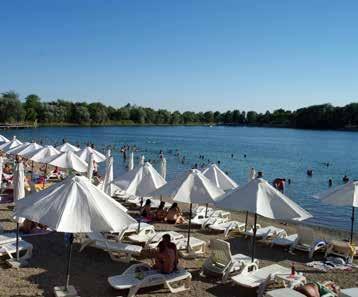

• Visiting the “wine village” of Gudurica
• Cycling around the Deliblato Sands (Deliblatska peščara) along the EuroVelo 6 route
• Eco-outings in Sušara, Straža and Jasenovo
• Grape Harvest Days – the Grožđebal Grape Ball, September, Vršac

• The Bela Crkva Flower Carnival, June
On the hill rising above the town stands the imposing Vršac Cas tle (15th century). Its dungeon tower is a symbol of Vršac. From here there is an unforgettable panoramic view of the expanse of the wine-growing hills and the Carpathians.
Jovan Sterija Popović, born in Vršac, was a great comedy writer and the father of Serbian drama. Vršac is also the hometown of one of the greatest Serbian and world poets – Vasko Popa. The “Following in the Footsteps of the Culture of Vršac” programme includes a visit to Sterija’s house.
The seven clean lakes of Bela Crkva attract those who want to relax on urban or completely wild, isolated beaches. Not too far away from the town, there is the “Deliblatska peščara” Special Nature Reserve, aka the Deliblato Sands. Thanks to afforestation of epic proportions, the sand dunes are covered in greenery and are an oasis for steppe landscape wildlife. We recommend visit ing the Zagajica hills.
There are seventeen orthodox monasteries on Fruška Gora mountain, all built between the 15th and the 18th centuries. For this reason, the area is known as the ‘Serbian Mount Athos’. In the surroundings of Irig, there are eight exceptional monastery complexes: Vrdnička Ravanica, Grgeteg, Krušedol, Velika and Mala Remeta, Staro and Novo Hopovo, Jazak. Each monastery is a treasure trove of delights that bear testament to the revival of the Serbs in the late Middle Ages.
Painter Jeremija dedicated his whole life to studying ritual breads. His fruitful dedication resulted in a museum which demonstrates the journey of a grain of wheat from the ground, turning into rit ual bread and then reaching the heavens.
In the village of Kupinovo near Pećinci, there are the remains of Kupinik, the royal town of Despot Lazarević, Đurađ Branković and his successors.
• Visiting the monasteries of Fruška Gora mountain

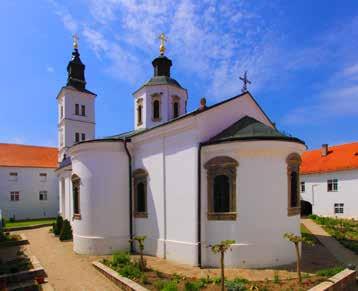
• The exhibition of the history of Srem, the Homeland Museum, Ruma
• The Serbian Museum of Bread, Pećinci
• The remains of the royal town of Kupinik
• Fruška Gora wines and grape brandy
• The meal of vineyard-keepers – “pudar paprikash
• Hams and sausages produced in Srem

On the road between Irig and Ruma, at the point where the plague was stopped, stands a unique monument! Irig was deci mated by an epidemic at the end of the 18th century, and the citi zens of Ruma who survived it built the monument as a token of their gratitude.
INFO
Tourist Organisation of Irig www.turorgirig.org.rs
Tourist Organisation of Ruma www.rumatourism.com
Tourist Organisation of Pećinci www.pecinci.org
• Mountaineering and cycling on the paths in Fruška Gora National Park
• Discovering the “Fruška Gora Wine Routes”
• A spa weekend at Spa Vrdnik
• Bird watching and canoeing in the Obedska Bara Nature Reserve
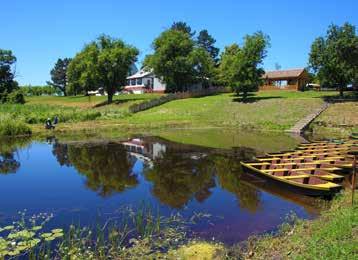
• Eco excursion to the protected habitat “Bara Trskovača” in Platičevo
• Wellness weekend at Borkovac Lake
• The Days of “Pudars”- vineyard-keepers, September, Irig
• The Ruma Fair, every 3rd of the month
• The Imperial Palace Visitor Centre (Sirmium)
• Žitni trg (Grain Square) and the pedestrian zone of the town
• The collections of the Museum of Srem
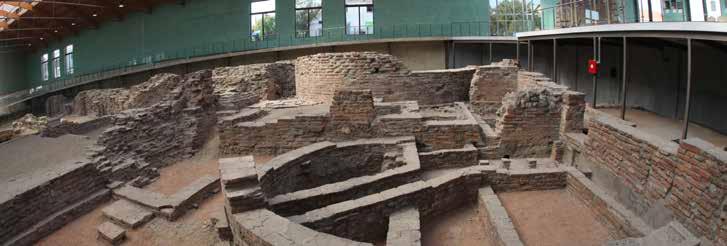
• Sava Šumanović Gallery and the Ilijanum Naïve Art Museum, Šid

• The monasteries of Kuveždin, Petkovica, Šišatovac and Bešenovo
• The monasteries near Šid: Berkasovo, Privina glava, Đipša
• The Syrmian Front Memorial Complex, Adaševci
• Cheese and sausages from Srem
• Specialities made with mangalitsa pork
• Kulen (paprika-seasoned sausage) and a glass of wine produ ced in Erdevik
What is a small town today, used to be one of the four capital cities of the late Roman Empire, with a population of over one hundred thousand people! The most significant building of ancient Sirmi um is the Imperial Palace. Today, its luxuriousness is evidenced by fragments of frescoes, mosaics and stone ornaments. In the an tiquity collection of the Museum of Srem, the unique sculpture of Atlas with a solar clock is exhibited, as well as items unique in the world: the gold coins of Constantine the Great.
In Mačvanska Mitrovica, a family related to Stojan Čupić, who was a general in the First Serbian Uprising – called the Dragon of Noćaj in folk songs, erected an Ethno House with exhibit.
Sava Šumanović is a great Serbian painter of the first half of the 20th century. He spent his youth and the last years of his life in the town of Šid. He marvelled at the landscapes and brightness of the flatlands and painted them in an impressive range of colours. Šumanović’s second favourite theme was the female nude. His paintings belonging to the Ladies from Šid collection are famous in the region.
Zasavica appeared as the result of the intertwining of the river flows of the Sava and the Drina rivers. Today, it is a special nature reserve. Zasavica is the habitat of a diverse marsh birds and old species of domestic animals. The reserve’s trademark is the rare umbra fish, known as ‘swimming dog’. The visitor centre has a tower with a view of the most beautiful part of the river.
• Boating in Zasavica and birdwatching

• Swimming in the Sava river in Sremska Mitrovica
• Resting in the village houses of Mačva and Srem
• Discovering the Srem wine routes
• Hunting in the forests around the village of Morovića
• The Rhetoric Festival, November, Sremska Mitrovica
• Days of the Mangalitsa Pig, December, Zasavica Nature Reserve
• The Pig Slaughter and Sausage Festival of Srem, February, Šid
The establishment and intertwining of Bukovička Banja Spa and Aranđelovac are inextricably linked to the great Serbian ruler Miloš Obrenović and his son Prince Mihailo. The medicinal water and construction undertakings of the Obrenović dynasty laid the foun dations of this fashionable European-style spa.
The sculptures made in marble from Venčac are exhibited in the well-tended park area of the spa. Thanks to the “Marble and Sounds” International Festival, today it is one of the most beauti ful open-air museums in the world.
• Bukovički Sculptures Park and the Old Edifice
• The collection of ceramic works at Aranđelovac Museum
• Risovača Cave
• The Marićević Trench Memorial Complex, Orašac
• Karađorđe’s Town (Karađorđev grad), Topola
• The Mausoleum of the royal house of Karađorđević, Oplenac
• A glass of “royal wine”
• Tasting of wines from the Šumadija region
• Karađorđe’s schnitzel (Karađorđeva šnicla)
• A glass of “Knjaz Miloš” medicinal water
• Researching the wine routes of Aranđelovac and Topola
• A visit to the Royal Winery, Oplenac
• A restful spa weekend in Aranđelovac
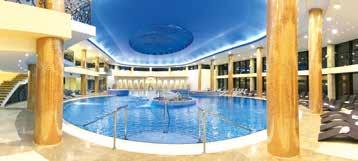
• Recreation at the Izvor Hotel’s Aqua Park
• Hiking the paths on Bukulja mountain
• The “Marble and Sounds” Festival, June – October, Aranđelovac
• Grape picking in Oplenac, October, Topola

The First Serbian Uprising began in Orašac and initiated the crea tion of the modern Serbian state. A memorial complex here in cludes the rallying point of the uprising – the Marićevića Jaruga trench, a church, a school and a museum. The museum holds au thentic items from this heroic period. The exhibition of photo graphs of the military decorations is especially interesting.
The Church of St. George, the mausoleum of the Karađorđević family, is covered in white marble on the outside, while the walls inside are covered in mosaics of the most beautiful Serbian me dieval frescoes. As many as forty million pieces were used to create these stunning mosaics. The town of the founder of the Karađorđević dynasty – Karađorđe Petrović, is located Topola, at the foot of the Oplenac Hill.

THE CAPITAL OF ŠUMADIJA IN THE GENTLE, ROLLING HILLS OF SERBIA
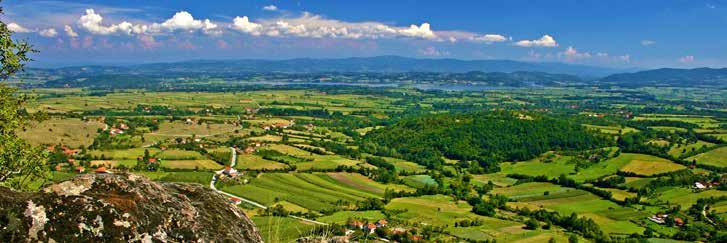
• “By the Cross” Square (Trg “Kod Krsta”) and the pedestrian zone of the city
• The historical complex of “Milošev venac”
• The National Museum and the “Old Foundry” Museum
• The “October in Kragujevac” Memorial Park (Šumarice) and Museum
• The monasteries of Rudnik: Blagoveštenje, Sveta Petka, Voljavča
• The church and the remains of the medieval town of Borač
• Kamenac Monastery, Gruža
• Hot brandy (vruća rakija) – “tea of Šumadija”
• Gibanica gužvara cheese pie and zeljanica greens pie
• Recreation on the lakes of Kragujevac
• Adventures in Kragujevac Adventure Park
• Mountaineering on the paths on the Gledić and Rudnik mountains
• Rest in the villages of Gruža and Rudnik
• Boating on Gruža Lake
• Climbing the Borački krš rocks
• The Great School Lesson (Veliki školski čas), 21st October, Kragujevac
• The “Gružanska jesen” Arts Colony, September, Knić
Upon the orders of the great Prince Miloš Obrenović, the first court, the first high school, the first newspaper and the first thea tre were established in Kragujevac – the first new-century capital city of the Serbian state. It was in this city that Serbian industry began: the first gun was cast and the first bulb shone light here, among a list of many other firsts.
The Prince’s Arsenal (Knežev arsenal) is a unique industrial mili tary and architectural compound. It consists of factory buildings and workshops dating to the end of the 19th and the beginning of the 20th centuries. Within the arsenal, there is the Old Foundry Museum (Stara Livnica), which exhibits the thrilling times and reaches of the industrial revolution.
The verses by Desanka Maksimović: “It happened in a land of farmers far away / in the hilly Balkans, / a troop of students / died martyred / on one single day”, are an upsetting testament to the brutality of the German occupiers who shot several thousand civilians in just two days in 1941.

According to the calculations of the Republic Geodetic Authority, the centre of Serbia is located in the village of Drača near Kragu jevac, exactly at 44º 01’ 13”N, 20º 49’ 27”E.
The Zastava factory was the biggest car producing factory in the former Yugoslavia. In 1955, the factory produced the first “Fiat 750”– the national vehicle that gained cult status, nicknamed the Fića. A total of 923,487 of the small-sized cars were produced in the factory! The Old-timer Festival – Fića Fest, traditionally takes place in Kragujevac.

Tourist Organisation of Kragujevac www.gtokg.org.rs
Tourist Organisation of Knić www.knicturizam.org.rs
• Trg kneza Mihaila (Prince Mihailo Square) and the Holy Trinity Church
• The Museum in Takovo and the “Takovski Grm” (Takovo Shrub) compound
• Prince Miloš’s Residence, Gornja Crnuća
• The monasteries of Vraćevšnica, Vujan and Bogovađa
• The ethno-village in Koštunići
• The Ravna Gora Memorial Compound
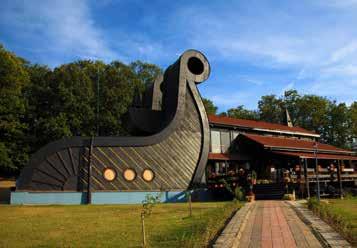
• The ‘1300 corporals’ monument on Rajac
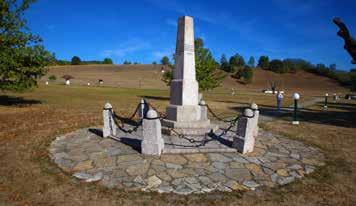
• A four-ounce glass of twice-distilled plum brandy (čokanj pre pečenice) and gibanica cheese pie
• Cabbage in an earthenware pot
• Climbing to the volcanic cone of Ostrvica
• Mountaineering on the paths on the Rajac and Rudnik mountains
• A spa weekend in Vrujci Spa
• Rest in the villages of the Takovo and Kolubara region
• Mountain biking along the Rajac–Drina route
• Recreation and rest at the “Momčilo Čeković” Centre
• The Rakijada fruit brandy festival, May, Pranjani
• Mowing on Rajac (Kosidba na Rajcu), July
• The “Mina Vukomanović Karadžić” Arts Colony, July, Savinac
The Second Serbian Uprising was initiated by Miloš Obrenović in Takovo in 1815. The rebels gathered around the old oak tree in front of the church, and according to folklore, there is a thunderhurler in the oak tree, and so the sacred tree gained the name ‘grm’. That great event in the history of Serbia was immortalised Paja Jovanović’s painting called “The Takovo Uprising”.
Serbian-Norwegian Friendship Prisoners from the former Yugoslavia, including forty or so from the Takovo region, were deported to concentration camps in Nor way by the Nazis. Many of them escaped death only thanks to the help of the Norwegian people. In a token of gratitude, the Nor wegian House was built, a building which architecturally blends a Viking ship with an old Serbian wooden house.
These verses are said when the church festival of mowing moun tain meadows begins – mowing on Rajac. The old custom of peo ple gathering together (called a “moba”) to help and to compete in mowing ends with a lunch which ladies who cooked it serve on the mowed field.

Tourist Organisation of Ljig www.turisticka.org
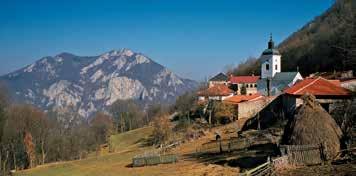
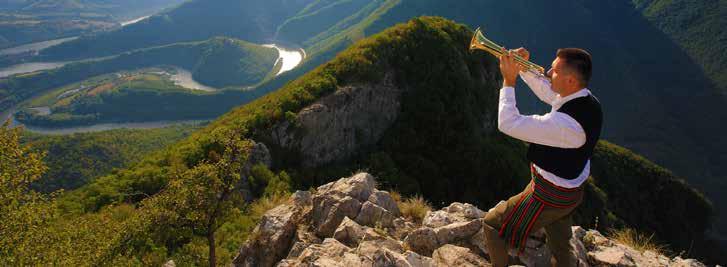
• The urban core of the city and the Roman Baths
• The museum exhibition in Residence of Jovan Obrenović
• The “Nadežda Petrović” art gallery
• The monasteries of the Ovčar-Kablar Gorge
• The monument to a trumpeter and the Trumpet Museum in Guča
In the region of the wonderful meanders of the West Morava river, which resembles the embrace of Ying and Yang, a unique com munity of monasteries known as the ‘Little Serbian Mount Athos’ was built during the 14th and 15th centuries. It is worth visiting some of the nine monasteries which served as sanctuaries for monasticism and the Christian faith during the time of the Turk ish invasion.
A Female Painter and Doomed Poet Nadežda Petrović, born in Čačak, is the originator of modern Ser bian painting. She painted the world with strong colours, as if she had not been affected by the melancholic world of the wars that she was voluntarily involved in as a nurse. She, as well as her fellow countryman, great poet Vladislav Petković Dis, died during the First World War.
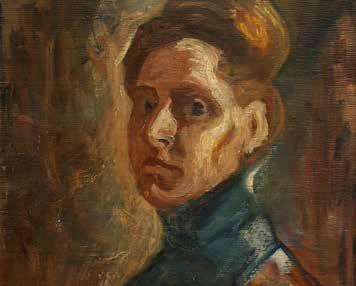
• Svadbarski kupus – a traditional slow-cooked dish of sour cabbage and meat
• Kajmak, which is similar to clotted cream, produced in Čačak and hot corn bread (proja)
• Spit-roasted meat (pečenje) with a small glass of a strong brandy called “ljuta”
• Mountaineering and paragliding in Ovčar and Kablar
• Tourist boat ride on Međuvršje lake
• Wellness weekends in the Atomska and Ovčar Spas
• Rest in the villages and ethno-complexes
• The “Disovo proleće” poetry event, March-May, Čačak
• The “Oj, Moravo” Serbian Flute-player Assembly, July, Prislonica
• The Ovčar-Kablar Regatta, July, Međuvršje
• The Dragačevo Trumpet Festival, August, Guča
Tourist Organisation of Čačak www.turizamcacak.org.rs
Tourist Organisation of Dragačevo www.turizamdragacevo.org
The shared memorial tomb in Čačak, where both Serbian and en emy soldiers killed in the First World War were buried, is unique in the world: here stand, all together, an Orthodox cross and a Catholic cross, the Islamic crescent and the Star of David.
In the centre of the beautiful, hilly landscapes of the Dragačevo region, there is the small town of Guča, which has nurtured with determination the tradition of national brass bands and in the process has gained international fame for its annual celebration of the town’s trumpet heritage – the renowned Guča Festival.
• The pedestrian zone and the urban heritage of Šabac
• The national museum and the House of the Dunjić Family

• The memorial complexes of the battles of Mišar and Cer
• Old Building of Koviljača Spa: Kur-salon, King Petar I Bath and villas
• Tronoša Monastery and the interesting village of Tršić
• The Mića Popović Gallery, Loznica

• Čokešina Monastery
• Jadar Museum and Vuk Karadžić House of Culture, Loznica
• Cheese and kajmak-stuffed peppers produced in Šabac
• Riblji kotlić (fish soup cooked in a traditional kettle) made in Loznica
• Recreation in the ambience of the Šabac Fortress on the Sava river

• Horse riding and horse races at the hippodrome in Šabac
• A wellness weekend in Koviljača Spa
• Rest in the villages of Mačva and the Drina river basin
• Rest at the “Sunčana reka” ethno-village on the Drina
• Walking and mountaineering on the paths on the mountains in the Drina river basin area
• Bathing at “Žićina” beach on the Drina river
• The Rose Festival, June, Lipolist
• The Šabac Fair, 21st September
• “Vukov sabor” (Vuk Karadžić Festival), September, Tršić
• International Regatta “There is Only One Drina”, August, Mali Zvornik
The dramatic events of the First World War took place in the vi cinity of Šabac and Loznica. Numerous monuments have been erected in recognition of these events and the huge number of victimst: on Cer, Gučevo, Mačkov kamen, Tekeriš. It is interesting that the strategy used in the battle of Cer is considered by many as a world “masterpiece of the art of war”.
In Tršić, the birth village of Vuk Stefanović Karadžić, the great reformer of the Serbian language, there is a unique ethno-park with a memorial house and amphitheatre built in the spirit of traditional architecture.
Šabac has the largest number of traditional taverns (kafana) “per capita” and that is why it is known as the “little Serbian Paris”. In these taverns, one can get a feeling for the distinctive, frolicsome and quick-witted local spirit.
In the village of Metlić, the Ašik’s Grave (Ašikov grob) memorial complex was built in memory of the tragic love between Pavle and Đula.
In the beautiful Mačva village of Lipolist one million rose seed lings bloom! In the month of June, a festival is held in honour of the “Queen of Flowers” and thousands of linden trees also begin to bloom in the village of Lipolist.
Tourist Organisation of Šabac www.sabacturizam.org
Tourist Organisation of the Town of Loznica www.togl.rs

• The King’s Underground Town, Mali Zvornik
• The Memorial Church of Holy Ascension and Mačkov Kamen
• The church and the ethno-complex in Dobri Potok, Krupanj
• Fish soup on the banks of the Drina river
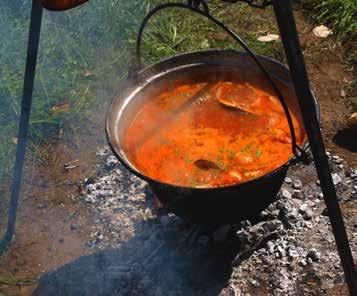
• Rađevski cheese and corn bread made under a shallow bellshaped metal lid (proja ispod sača)
• Meals made from forest mushrooms
•
• Rafting, white water rafting and kayaking down the Drina river
• Angling on the Drina
• Investigating the Trešnjica, Tribuća and Ljuboviđa canyons
• Mountaineering on the paths on Bobija mountain
• Rest in the ethno-village of Vrhpolje and Radaljska Spa

• Mountain biking on the mountains in the Azbukovica area
• Rest in local village houses and fishermen’s houses built on stilts
• The Drina Regatta, July, Ljubovija
• The Somovijada Catfish Festival, July, Mali Zvornik
“Plodovi Radjevine” Local Food and Drink Festival, Krupanj
Legend says that Soko Grad Fortress was built in the clouds and was not once conquered in its history. Today, on the foundations of one of the towers, there is a big gold-plated cross – the symbol of the monastery in Soko, dedicated to Bishop Nikolaj Velimirović.
Deep inside the hollow rock that drops vertically into the Drina river, there is the secret underground town of the Karađorđević dynasty. The labyrinths, numerous chambers and chapel were all built as a shelter for the king and the High Command in 1932.
The large Zvornik Lake was created during the construction of the “Zvornik” hydropower plant on the Drina river. The power plant was opened in 1955 and, given its size, was a real construction miracle of its time.
The Church of Holy Ascension in Krupanj and the memorial crypt on Mačkov Kamen are part of the same memorial complex built as a sign of remembrance of a great battle of the First World War. Interestingly, the church candelabrum is made from the bullets, bayonets, swords and grenades collected on the battlefield.
Tourist Office of Ljubovija www.tolj.rs
Tourist Office of Mali Zvornik zvornikturizam.org
Tourist Office of Krupanj www.tookrupanj.org.rs
• Tešnjar – the old Valjevo bazaar
• Trg vojvode Mišića (Duke Mišić Square) and the pedestrian zone of the town
• The National Museum, Valjevo
• Exhibitions at Muselim’s Residence and Nenadović Tower
• The Modern Gallery of Valjevo and Ljuba Popović’s Collection
• The monasteries of Jovanja, Pustinja, Ćelije and Lelić
• The birth house of Duke Živojin Mišić, Struganik

• Stone Museum, village of Paštrići near Mionica
• Duvan čvarci ‘tobacco’ pork cracklings with a pint of Valjevo beer
• Beans with pork knuckle accompanied with a glass of šljivovica plum brandy
• Visiting the Petnica cave and recreational activities at the Petnica Sport Centre
• Rest at the hotels and apartments in Divčibare
• Swimming and fishing with artificial flies on the Gradac river
• The “Valjevski Izazov” adventure race organised by the Wild Serbia Association
• A spa weekend in Vrujci Spa and rest in the Mionica villages
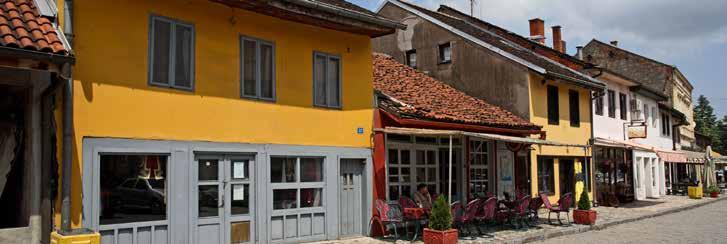
• The “Desankini majski razgovori” literary event, May, Brankovina
• Valjevo Jazz Fest, May
• The “Tešnjarske večeri” summer festival, August, Valjevo
• Festival of Duvan Čvarci (tobacco-shaped pork crackling ‘crisps’), Valjevo
• Mišić’s Days, July, Mionica
• The Plum Fair, August, Osečina

Brankovina – the Pantheon of the Glorious Brankovina village is the birthplace of several great persons from Serbian history: Prince Aleksa Nenadović and his ancestors Duke Jakov, head-priest Mateja, Dukes Sima and Jevrem. Desanka Ma ksimović, a poet, was said to have made Brankovina famous – she was born and buried there. Today, it is an interesting, well-pre served village with a church, a school, monuments and old village houses.
The National Museum of Valjevo has numerous features of interest. There is an exceptional museum exhibition which leads visitors through the revived “gates of time”.
The Battle of Kolubara (1914), which was commanded by Duke Ži vojin Mišić, is a prime example of the art of war. The memory of this great strategist is preserved in his birthplace Struganik. Valjevo is one of the few towns that proudly preserves the memory of the heroes of the Second World War. The Sculpture Park on Jadar and the Monument to the Revolution on Vidrak testify to this.
Because of its extraordinary beauty and diversity of flora and fa una, the canyon of the Grac river was declared a landscape of exceptional features. The Gradac river is one of the cleanest in Europe, and its rapids attract people who love fly fishing. In the gorge, there is also an exceptionally valuable monastery – Ćelije Monastery (14th century). The most beautiful spring of all is in this region – the Taor Springs (Taorska vrela) – is certainly worth seeing.
The Old Town is the symbol of Užice, located high on a ridge sur rounded by the Đetinja river on three sides, and the town takes great pride in the beautiful beach on that rapid-flowing mountain river. Every year, in the beginning of August, there is an intere sting competition in jumping into the river from the old bridge above the beach.
In the troubled year of 1941, when Hitler had already overrun the whole of continental Europe, a PA system in the main square in Užice broadcast the news from radio Moscow and London. Užice was the central town the great liberated territory of the Republic of Užice. It was the only island of freedom in all of Europe.
• The centre of Užice – Trg partizana (Partisan Square)
• The National Museum and the exhibition at Jokanović’s House
• The Museum of Technology, the hydropower plant on the Đetinja river
• The Kadinjača Memorial Complex
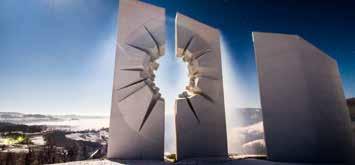
• The white church in the village of Karan and Đurđic Monastery in Godovik
• Railway Museums in Požega and Mokra Gora
• The memorial complex dedicated to Prince Miloš Obrenović, Gornja Dobrinja
• Wooden Church in Seča Reka
• Užice smoked ham with a small glass of Požegača plum brandy
• Komplet lepinja (a type of bun with meat dripping, egg and kajmak)
• Ride the Šargan Eight railway

• Skiing in Drvengrad and on Tara
• Recreation on Đetinja beach
• A visit to Potpećka Cave
• Take a break in the ethno-park of Terzića avlija (Terzić’s Gar den), the village of Zlakusa

• Mountaineering on the paths on the mountains of Jelova Gora, Povlen and Maljen
• The International Film and Music Festival “Kustendorf”, January, Mokra Gora
• Licidersko srce (Liciter Hearts), August, Užice
• The International Colony of Ceramics and Pottery, Zlakusa
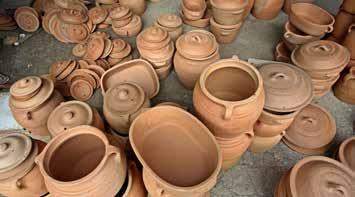
• The “Interakcija” international student film camp, August, Požega
• Shepherds’ Days, July, Kosjerić
The ‘Eight’ (‘Osmica’) narrow gauge railway tracks exist thanks to ingenious engineers. The incline of the Šargan Bend had been im passable before the railway tracks were built in the shape of the curving circles of the number eight. And another miracle happe ned on Šargan: while shooting his film “Life is a Miracle”, the fa mous film director Emir Kusturica discovered the sunny hill of Mećavnik and built his fairy-tale-like town made of wood there.
An outstanding museum collection of old locomotives, wagons and special machinery is on display next to the new train station in Po žega, on the four old tracks and in the station building. Rarities include the “Rama” German locomotive, from 1873, and the first lo comotive produced in the Balkans which was named “Milan” after King Milan Obrenović. Other interesting exhibits include the salon of Emperor Joseph and the “Partisan armed personnel carrier”.
Tourist Office of Užice www.turizamuzica.org.rs
Tourist Office of Požega www.topoz.org.rs
Tourist Office of Kosjerić www.odmorukosjericu.rs

• The town centre of Bajina Bašta
• Rača Monastery on the Drina
• The waterfall on the Vrelo river, Perućac
• The Mramorje Stećci Tombstone Sites on the UNESCO List –Perućac and Rastište
• Grilled trout
• Local cheese and kiselo mleko (cultured dairy product)
• A small glass of kleka juniper brandy, stara pesma or sokolova brandy
The endless forests, the magnificent view from the viewpoints, the canyon of the Drina river, the lakes and the beautiful land scape of the National Park led the director of a European nature protection foundation to describe Tara as an earthly heaven. The flora and fauna of Tara were also researched by the great Serbian botanist Josif Pančić as early as the 19th century and he discov ered a tree dating back to the ice age! In his honour, the tree was named Pančićeva omorika (Serbian Spruce).
The Predov Krst area of the canyon of the small river of Derventa in the very heart of the National Park is an ideal place for a rest, far away from the reach of civilisation.
One of the symbols of Bajina Bašta, and the entire region of Podrinje, is an isolated house made of logs on a river rock. “The Little House on the Drina” (Kućica na Drini) has been resisting the torrents for almost half a century, and this very unusual boat men and swimmer’s refuge is one of most photographed scenes in Serbia that has been seen around the world.
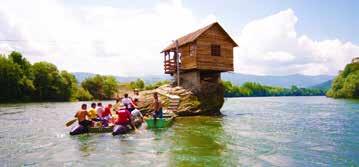
• White water rafting, rafting and fishing on the Drina
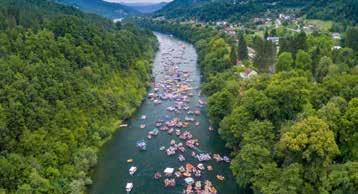
• Drina Canyon cruise: “Magical Tourist Ring”
• Rest and swimming in the Perućac and Zaovinsko lakes
• Rest in hotels - Kaludjerske bare and Mitrovac
• Visiting the observation points of Banjska and Bilješka stena, Crnjeskovo, Kapija Podrinja
• Mountain biking on the paths on Tara – “Tarocikl” (Tarocycle)
• Mountaineering, horse riding, stand up paddling, canyoning and rally driving
• Xross Challenge, June, Tara
• The Drina Regatta, July, Bajina Bašta
• Bašta Fest, July, Bajina Bašta
• Rača Days by the Drina, October
Serbia, Montenegro, Bosnia and Herzegovina and Croatia entered their medieval necropolises of standing tombstones on the World Heritage List. They are a unique cultural phenomenon of the Bal kans. The “Mramorje” sites in Perućac and the village of Rasište near Bajina Bašta are a living testament to the long and rich his tory of this region.
Tourism-oriented Zlatibor saw the light of the day, as is always the case in any good story, when a king showed up. The Serbian mountain gem began to develop in 1893, when King Aleksandar Obrenović visited Zlatibor. At the spring of Kulaševac, Kraljeva česma (King’s Fountain) today, the king approved of the idea to have an air spa built. Since then, that sunny mountain with thera peutic air has never stopped developing.
The open-air Staro Selo (Old Village) Museum is unique in Ser bia. Located on a beautiful glade one can gain a detailed insight into the extinct world of highlanders: the museum exhibition con sists of authentic log-built houses with traditional furniture and hand-made objects, the rooms where fruits were dried, casks for holding brandy and pottery.
• The centre of Zlatibor and the lake on Kraljeve vode (King’s Waters)

• The museum complex of “Staro selo” (Old Village), Sirogojno
• The Museum of Women Knitters from Zlatibor, Sirogojno
• Uvac Monastery and wooden churches of Zlatibor
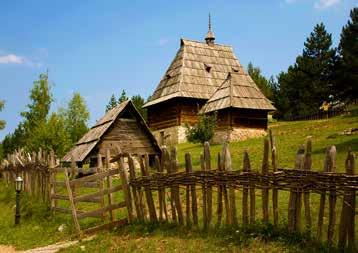
• Komplet lepinja - a flat bun with meat dripping, eggs, kajmak and kiselo mleko
• Zlatibor bites: pršut smoked ham, cheese, kajmak (similar to clotted cream)

• A small glass of homemade šljivovica plum brandy
• Tea made from mountain herbs
• Rest at the hotels, villas and resorts
• Walks and mountain biking on the “Ozone Paths” (“Ozonske staze”)
• Recreation on sports courts and in swimming pools
• Winter sports and skiing at the Tornik centre
• Horse riding and paragliding
• Fishing on Ribničko Lake
• Fun and recreation at the Dinosaur and Adventure Park
• The “Pršutijada” Smoked Ham Fair, January, Mačkat
• The “Rakijada” Local Brandy Fair, July, Šjivovica
• The Zlatiborsko leto (Zlatibor Summer) cultural event
• The Trumpet Festival and Assembly of Folk Creations, July
• International Festival of Sports Film, July
• The “Pesničke vatre zlatiborske” literary and music festival, September
Hand-knitted unique jumpers with the motifs of the Zlatibor region have made Sirogojno famous. More than half a century ago, fashion designer Dobrila Smiljanić brought together a band of skilled knitting-women and put them onto the world stage. These knitted jumpers from Sirogojno have been worn by the likes of Queen Elizabeth II, Nancy Reagan and Raisa Gorbacheva. Stopića Cave and the Gostilje Waterfall
The Stopića Cave monument of nature is located near the village of Rožanstvo. The stone tubs, in which water collects and then overflows in the form of unique cascades, give it a special beauty. The waterfall on the Gostilje river is also worth a visit.
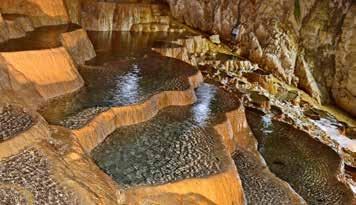
• The Town Museum and the Museum of Vlade Divac, Prijepolje
• The Sahat-kula (Clock Tower) of Prijepolje
• The Monastery of St. Nicholas and the treasury, Priboj
• The Homeland Museum, Priboj
• Buckwheat pie and Zlatar cheese
• Pribojske ćeške – chicken with barley
• The national elixir vodnjika (fruit pickle) and the sita fruit syrup
The White Angel of Mileševa Monastery is one of the most beau tiful works of European medieval art. Together with photographs of mankind on the Moon and the Great Wall of China, the White Angel was broadcast as the first satellite signal of the achieve ments of the people of Earth sent from Europe into outer space.
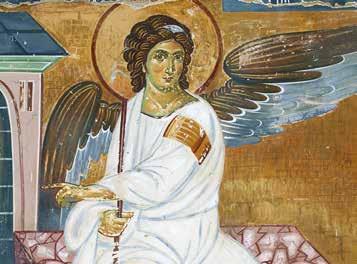
On the Sopotnica, a tributary feeding into the Lim, there are cas cading waterfalls of unusual beauty which are amongst the gems of what tourists can enjoy in this region.
The meanders of the Uvac river are considered one of the most beautiful, panoramic views that Serbia has to offer. The most at tractive part is its canyon made of a series of “hairpin” meanders, some of which turn at an unbelievable 270 degrees. Rare Griffon vultures – an endangered type of giant eagle-vulture, live in this area.

The prehistoric mine of Jarmovac near Priboj is one of the nine centres for studying the occurrence of copper metallurgy on Eu ropean soil. The exhibition named “Following the Traces of the Miners of Jarmovac” at the Homeland Museum presents the ex citing findings from this site.
• Rafting and white water rafting on the Lim river
• Trekking through the canyon of the Mileševka river
• Mountain biking and paragliding (Kamena Gora and Prijepolje)
• Kayaking and swimming on the lakes of Zlatar
• Skiing and mountaineering on the paths on Zlatar
• Nova Varoš – Golo Brdo walking and cycling tour

• Rest in Pribojska Spa and a stay in village households

• The Lim Regatta, May
• Zlatarfest and the Zlatar Cheese Festival, July – August, Nova Varoš
• The Lim Poetry Evenings, December, Priboj
• The ambience of Ivanjica town centre
• The Church of the Holy Emperor Constantine and Empress Jelena
• The hydropower plant on the Moravica and the stone bridge
• The Church of St. Achillius in Arilje
• The Arilje town centre and Residence of Serdar Mićić
• Klisura Monastery
• Potato cooked under a shallow bell-shaped metal lid in the local Ivanjica way
• Golija mezze: smoked ham, cheese and hot brandy
• Raspberry cake and juice
• A weekend at the RH Centre and the Park Hotel in Ivanjica

• Visiting the Golija Nature Reserve – Studenica
• Mountaineering and mountain biking on the paths on Golija and Javor
• Rest in the villages around Ivanjica and Arilje

• Swimming on the beaches of the Rzava and the Moravica rivers
• Skiing at the Odvraćenica and Dajići centre
• The Traditional Serbian Song Festival, August, Prilike
• The Nušićijada comedy festival, end of August, Ivanjica
• ARLEMM Classical Music Festival, July, Arilje
• Days of Raspberries and Textiles, July, Arilje
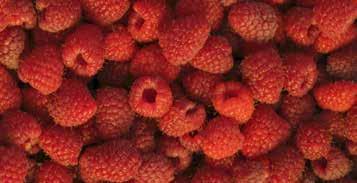
The beautiful small town of Ivanjica was built ‘in the lap of seven mountains’ – Golija, Javor, Mučanj, Čemerna, Čemernica, Radočela and Kukutnica. Golija is the most famous mountain of the Ivanjica region and was declared a Biosphere Reserve by UNESCO because of its outstanding nature. Ivanjica is the first Serbian air spa.
At a time when electricity was unheard of in numerous European cities and towns, the Moravica hydropower plant began working here in 1911. The words “the eternal day begins in Ivanjica today” were said by the citizens of Ivanjica at the opening ceremony. The hydropower plant still operates today, and there is a particularly nice plateau with a view of the waterfall.
The Church of St. Achillius in Arilje (13th century) is the legacy of King Dragutin of the ruling Nemanjić dynasty. Architecturally it belongs to Raška School style and has extraordinary frescoes. Apart from the Ktetors’ (founders’) composition, there is the fresco of St. Archangel Gabriel, which was praised in the verses written by the great poet Branko Miljković: “He who has not seen you has no knowledge of Himself…”
On the Veliki Rzav river near Arilje, one of the cleanest rivers in Europe, you can bathe on one of the maintained beaches: Bosa noga, Urjak, Sonine čari or Uski Vir. The Visočka Spa, with its thermal mineral water springs and attractive “hanging” spring heads in the rocks above the river, is a rarity of nature.
Tourism Organisation of Ivanjica www.ivatourism.org
Tourism Info Centre of Arilje www.visitarilje.com
• Mountaineering and skiing on the paths on Golija mountain
• Rest in the villages at the foot of Golija
• Spa weekend in the Novi Pazar and Rajčinovića spas

• Camping and fishing on Sjenica Lake
• Mountain biking and motorcycling adventures in the Pešter plateau
• Alpine and Nordic skiing on Babinjača (Pešter)
• A trip to Borići close to Sjenica
• The Stari Grad Music Festival, August-September, Novi Pazar
• Dani Sjeničke Pite – Sjenica Pie Festival, August
• UNESCO Heritage – Stari Ras (Old Ras) with Sopoćani
• The Old Bazaar of Novi Pazar and the Fortress
• The Altun-Alem Mosque and Isa-Bey’s Hammam
• The Homeland Museum of Ras
• The Valide Sultan Mosque, Sjenica
• Kumanica Monastery
• Sjenica cheese and sudžuk – a dry, spicy sausage
• Pešter lamb
• Novi Pazar style ćevapi (grilled minced meat kebabs) and mantija pies

Thanks to the monuments on the UNESCO list: the monasteries of Sopoćani and Đurđevi Stupovi (St. George’s Pillars), the Church of the Holy Apostles of Peter and Paul, the remains of the town of Ras –the first capital of Serbia, but also to its own special history through which the Christian and Islamic civilisations intertwine and face one another, Novi Pazar gained the title of European Destination of Ex cellence. The world was for the most part amazed by the frescoes of Sopoćani: the Ascension of the Holy Mother of God at the world ex hibition in Paris in 1961 was declared the most beautiful fresco of the Middle Ages. In the face of the Sopoćani St. Apostle Philip, art his torians see the genius handwriting of the nameless ‘Serbian Giotto’.
The precious gemstone of the Islamic architecture here is repre sented by the Altun-Alem Mosque in Novi Pazar (16th century).
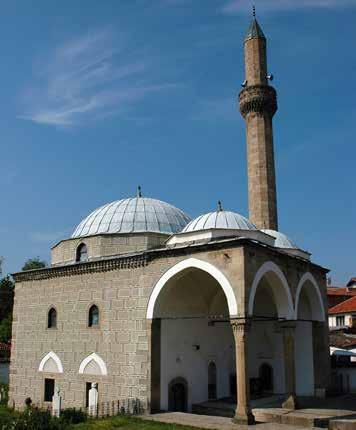
The town fortress with its lookout tower, the Old Bazaar and the complex surrounding the mosque creates a very special ambi ence. The old hammam (15th century), built by the founder of the town – Isa-Bey, is also preserved in its original state.
As the fairy tale of the seven mountains says, the Pešter plateau is located between the seven mountains which, together, are a magnificent sight. The largest plateau in the Balkans is a place of untouched nature, pastures, rivers that disappear underground and hospitable highlanders of Pešter with the spirit and outlook of bygone days.
Tourism Organisation of Novi Pazar www.tonp.rs
Tourism Organisation of Sjenica www.turizamsjenica.com
• The town centre of Raška
• The memorial room “Raška – War Capital of the Kingdom of Serbia 1915“
• The monasteries of Gradac, Stara and Nova Pavlica (New and Old Pavlica), Končul
• The town centre of Brus and the promenade along the Rasina
• Lepenac Monastery
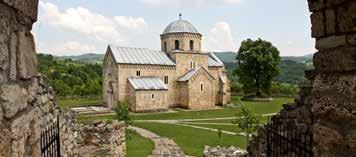
• The national sanctuary of Metođe
• Masenica or uštipci (doughnuts) with kajmak (similar to clotted cream)
• Slatko fruit preserve made with forest strawberries and blue berry juice

• Brus nettle steaks (šnicle od koprive)
• Winter sports at the Kopaonik centre
• Mountaineering on the paths in the National Park
• Mountain biking on the “Kop Bike Park” paths
• Adventure Park and adrenaline sports
• Horse riding, paragliding, canyoning, archery
• A panoramic ride on the ski-lift

• A wellness weekend in exclusive hotels
• Wellness treatments in the renovated bath of Jošanička Spa
• Spiritual Celebrations in Raška, August, Raška
• Days of Queen Helen, May, Raška, Gradac Monastery
• The Zlatne ruke Brusa (Golden Hands of Brus) traditional event, August, Brus
Pančić’s Choice
Kopaonik is the biggest and the highest mountain in central Ser bia and, for that reason, is known as the ‘roof of Serbia’. Deep inside the volcanic mountain, therapeutic waters such as the hot springs of Jošanička Spa, can be found. The great Serbian natu ralist Josif Pančić chose one peak of Kopaonik with a marvellous view as the place where he would eternally rest in peace. Today, his mausoleum is located there and the peak is named after him.
The landscapes of Kopaonik hide extraordinary, unexpected plac es worth seeing, including the poetically named archaeological site “Heavenly Chairs” (Nebeske stolice), the floating island on Lake Semeteš, the beach on the Samokovska river, waterfalls, the viewpoints and the white rocks.
French Princess Helen of Anjou married Uroš I Nemanjić and thus became Queen of Serbia. People loved this educated and noble lady who deserved to gain the status of a Serbian female saint for the good deeds she had done. Queen Helen built the Church of the Mother of God of Gradac Monastery, where she was bur ied. Today, it is a nunnery, whose sisterhood show their respect for the holy female founder and cherish the highest quality iconpainting art and modern art.
Tourism Organisation of Raška www.raska-turizam.rs www.lovekopaonik.com
Tourism Organisation of Brus www.turizamopstinebrus.co.rs
• The Studenica and Žiča monasteries
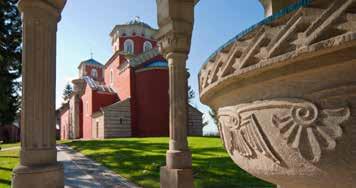
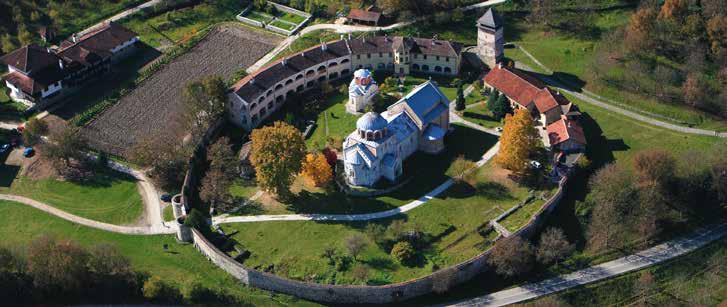
• The symbol of the city – Trg srpski ratnika (Square of Serbian Warriors)

• Trg Sv. Save (Square of St. Sava) and the “Vladika Nikolaj Veli mirović” Spiritual Centre
• The Church of the Holy Trinity and the National Museum exhibition
• The medieval town of Maglič
• Kajmak (similar to clotted cream) and hot pogača bread
• Beans with dry ribs with a small glass of ljuta brandy
• Trout from Studenica
• Rafting and fishing on the Ibar river
• Extreme sports on Stolovi and Goč mountains
• Rest and skiing in Dobre vode, Goč
• Mountaineering on the paths on Goč
• A weekend in Mataruška, Bogutovačka and Lopatnica Spas
• The Narcisu u pohode mountaineering and recreation event, May, Stolovi
• Maglič Fest, May, Maglič Fortress
• Days of Lilacs, May, Kraljevo
• The Veseli spust race event, June – July, Ibar river
• Silver Cauldron Bean Festival, September, Kraljevo
The Church of the Virgin at Studenica Monastery gives off a dazzling whiteness. It was built using white marble and decorated with stone decorations and its beauty is unsurpassed in Serbian medieval art. The famous fresco of Studenica is the monumental “Crucifixion”, and the entire complex is on the UNESCO World He ritage List.
Žiča Monastery is the first seat of the Serbian episcopacy built on a carefully chosen site – equally distanced from the Byzantine Con stantinople and the Latin Rome. Žiča is known as the coronation church of Serbian rulers. The emblem of the city of Kraljevo contains seven crowns symbolising the crowning of the seven Serbian rulers. According to legend, a new door was opened for each king, and for that reason, the monastery is called the ‘seven-door Žiča’.
When Serbian King Uroš I Nemanjić was about to marry French Princess Helen of Anjou, he ordered that the whole valley of the Ibar river should be seeded with lilacs so that the landscape wo uld remind the queen-to-be of her native Provence.
The village of Rudno on a plateau of the same name is located within the boundaries of the “Golija – Studenica” biosphere re serve. One of the impressive experiences the village offers is the view of the night sky. The Rudno heights are third in Europe for visibility of the starry night sky.
• The first view of the town: the Promenade in Vrnjačka Banja
• The one-hundred-year old park and the Thermal Bath
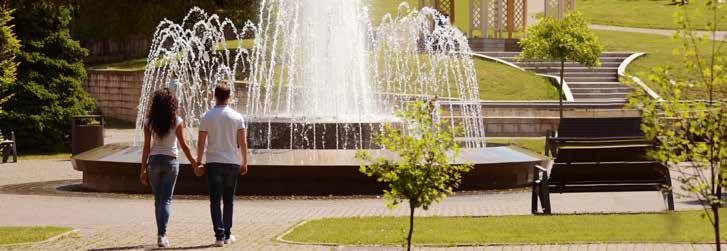
• The Homeland Museum in Belimarković Castle

• The old buildings on Čajkino Brdo hill and the Japanese garden
• The Temple of the Birth of the Most-Holy Mother of God
• The Bridge of Love on the Vrnjačka river
• Morava fish soup cooked in a traditional kettle pot
• Veal cooked under a shallow bell-shaped metal lid (ispod sača)
• Goč cheese and kajmak (similar to clotted cream)
• Wellness and spa weekend programs
• Recreation in swimming pools and various sports courts

• Riding in a horse-drawn carriage and walking the fitness paths
• Mountaineering and skiing on Goč
• Fishing on Podunavačke Bare ponds
• Vrnjačka Banja Carnival, July
• Film Scenario Festival, August
• Love Fest, August
The ancient Romans treated their illnesses in Vrnjačka Banja, and the Fons Romanus site is a testament to that. The modern spa was born in the summer of 1868, when the first season there was officially opened. Today, as many as seven therapeutic springs are used: Topla voda, Slatina, Snežnik, Jezero, Borjak, Beli izvor and Vrnjačko vrelo.
The town takes pride in its “Castle” which used to be the summer house of General Belimarković, built near the end of the 19th cen tury. The symbol of the town and the most frequently seen motif on postcards is that of its Thermal Bath (Termalno Kupatilo) and the large floral arrangement in the centre of the park. There are also spacious parks reflecting European garden architecture and more recently, a new Japanese garden has been created.
Ever since the spa was founded, people have been coming here for treatment, to recharge their batteries and to have fun socialis ing. The tradition of organising balls and kermes (crafts fairs) has been kept alive, with some changes in the form, to this day. The Vrnjačka Banja Carnival is the best event representing this spirit of keeping tradition alive.
An old story of the town speaks of a love ended by the First World War. The wind of war brought Officer Relja to Greece, where he fell in love with another girl and married her. But back home, Nada could not forget him. She waited for him on the bridge where they used to date until the day she died. Watching her pining for her lost lover, girls of the town started going to the bridge at night to “lock” the hearts of their boyfriends.

• The old bazaar and the Church of the Holy Trinity, Trstenik
• The monasteries of Ljubostinja, Veluće and Kalenić

• The Museum of Winemaking and Viticulture, Aleksandrovac
• The winegrowing settlements of “poljane” (the fields)
• The medieval castle of Koznik
• Drenča and Rudenice monasteries
• Fish soup cooked in the Morava region
• A glass of Prokupac wine and Tamjanika wine
• Spit-roast meat made in Stopanja and Veluće
• Exploring the wine routes of Župa
• Biking on the “Princess Milica” (Kneginje Milice) path and the “Old Crafts” route (Starih zanata)
• A panoramic flight from the Trstenik Sports Airport
• Rafting on the Morava river and camping in Mitrovo Polje
• A visit to the ethno-villages of Latkovac and Rakezići

• “Jefimija’s Days”, June, Trstenik
• The “Pečenjijada” Roast Meat Festival, September, Stopanja
• The “KozArt” International Festival of Classical Music, August, Aleksandrovac
• Grape Picking in Župa, September, Aleksandrovac
• The “Prođoh Levač, prođoh Šumadiju” folk creations festival, August, Kalenić Monastery
The construction of Lubostinja Monastery began on the eve of the Battle of Kosovo. According to legend, Princess Milica had chosen that place for her endowment because it was here that she met her future husband, Prince Lazar. The name of the monastery means ‘place of love’ in the Old Church Slavonic language. It is in Lju bostinja that the most beautiful verses of medieval literature were written and silk embroidered by Jefimija, a noblewoman and nun.
In Župa, vines started to be grown as early as in the times of An cient Rome, and the first written mentions of the winegrowing hills date back to the end of the 12th century. Famous Prince Lazar Hrebljanović had his cellars on the field of Kruševica. The most fa mous variety of grape in Župa is the prokupac grape, which dates back some 1,000 years, whereas another somewhat younger vari ety of grape is tamjanika, which has an intense aroma.
The picturesque Old Bazaar in Trstenik reminds us of a time when trade and skilled craftsmanship were on the rise. The region of Trstenik has managed to preserve part of that tradition as it is known worldwide for its grafters from the village of Velika Dren ova and masters of rosette and watermill stone chiselling.
The richly decorated Kalenić Monastery is among the jewels of Morava School of architecture. It is known for its outstanding stone ornaments, the “Wedding in Cana” and the “Holy Warriors” frescoes, the verses of the poet Vasko Popa.
Tourism Organisation of Aleksandrovac www.toa.rs
Tourism Organisation of Trstenik www.turizamtrstenik.rs
Tourism Organisation of Rekovac www.torekovac.com
• Mountain biking on the “Jastrebačkog trougla” (Triangle of Jastrebac) paths
• A spa weekend in Ribarska Spa
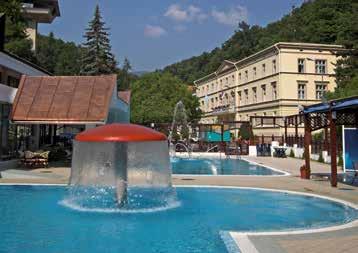
• Wine tours in Kruševac and Župa
• “From Đunis to Stalać”, white water rafting on the South Morava river
• Trekking on the Mojsinje mountains
• The Kulturno Leto summer cultural festival, Ribarska banja
• The urban core and Trg kosovskih junaka (Square of the Heroes of Kosovo)
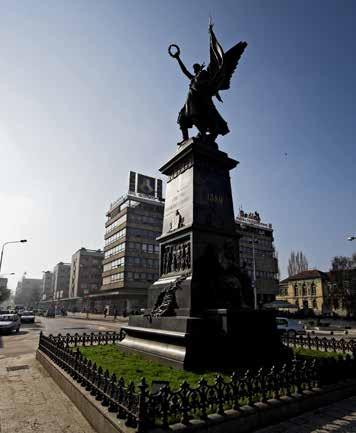
• The Lazarev Grad (Lazar’s Town) archaeological park
• The Mosaic Hall in the Town Hall
• The House of the Simić Family and the Gallery of Milić of Mačva
• Slobodište Memorial Park
• Naupara Monastery
• Grilled meats (roštilj) and a glass of “Car Lazar” red wine
• Rubin wine brandy served with orasnice walnut cookies with honey
Kruševac is a town heavily marked by the rule of Prince Lazar Hrebeljanović, who built it as his new capital in 1371. Apart from the re mains of the fortress and the famous Lazarica Church, one should also see the replica of the prince’s garb, as well as the model of Meštrović’s unrealised grandiose St. Vitus Temple (Vidovdanski Hram).
The Monument to the Heroes of Kosovo leaves its mark on the town from which the Serbian army, led by the prince, went off to what was a tragic battle. The central composition shows the wounded flag-bearer Boško Jugović fighting with his broken sword. When death was close, a fairy came, took the flag sym bolising the fight of the generations to come and, with her arm raised, showed the way to Kosovo. The monument was built by sculptor Đorđe Jovanović.
The special sense of humour and talent for acting are what make the spirit of the town. Kruševac Theatre has produced a large number of extraordinary actors. The strong spirit of this old, prosperous small trading town and that of the strong industrial town, too, has been preserved.
The village of Bela Voda near Kruševac is known for its excep tional sandstone which has been extracted from several quarries for six centuries now. Some of the most famous medieval monas teries are made from it. The village is also known for its excellent stonecutters and the Museum of Stonemasonry and Sculpture of the Morava School.
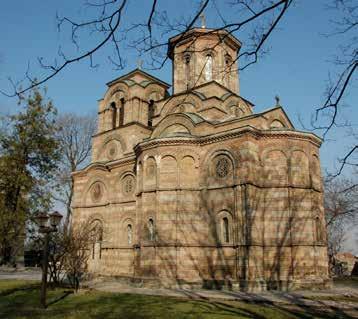
The sports and tourism complex “Potok Đurđevo brdo” consists of several interesting amenities: The Museum of Wax Figures, the only one in Serbia, a large Aqua Park and an attractive Zoo. George’s Hill (Đurđevo brdo) is a manicured park with a summer stage and has linden-trees that are one hundred years old.
Janko Brašić, a famer and artist from the village of Oparić, is largely responsible for the existence of the Museum of Naïve and Marginal Art in Jagodina. His paintings were the beginnings of a collection which today contains the works of self-taught artists from the former Yugoslavia and Europe. In this lavish world of colours and motifs, one can see the works of the world classics such as Sava Sekulić, Ilija Bašičević Bosilj and Emerik Feješ.
• The town centre and the Church of St. Apostles Peter and Paul
• The Homeland Museum in Sokolski Dom
• The Museum of Naïve and Marginal Art

• The town centre of Ćuprija
• The Horreum Margi Ravno Museum, Ćuprija
• The “The Battle of Ivankovac” (Boj na Ivankovcu) Memorial Park, Ćuprija
• The Ravanica and Jošanica monasteries

• Roast turkey and a glass of jagodinska ružica wine
• “Drunk” carp made in Bagrdan (pijani šaran)
• A pint of Jagodinsko beer

• A weekend at the Aqua Park and a visit to the Zoo
• An outing to the town park of “Đurđevo brdo” (George’s Hill)
• Visiting the cave of Ravanica
• Fishing on the Bagrdan Lake
• A rest in the ethno-village of “Morava Garden”
• The Dani komedije comedy event, March, Jagodina
• The Ulična trka street race, October, Ćuprija
Organisation of Jagodina
Organisation of Ćuprija
Ravanica Monastery of (14th century) is the legacy and burial church of Prince Lazar Hrebeljanović. Dramatic events in the his tory of Serbia can be learned here in the story of the fate of the prince’s earthly remains: in the great migrations of the Serbs at the end of the 17th century, the relics of the holy prince were first taken to Szentednre, then to the Vrdnik monastery on Fruška Gora mountain. During the Second World War, the prince’s cof fin (ćivot) was brought to the Orthodox Cathedral Church in Bel grade. Six centuries after the Battle of Kosovo, in the 1989, the holy emperor came back to rest in the peace of his Ravanica.
Today’s Ćuprija existed in the Roman times under the name Hor reum Margi, which means the Granary of the Morava. Numerous traditional songs have been sung about the Morava, celebrating its fertility as well as its temperament.
• The town centre and the Church of the Holy Trinity, Paraćin
• The Homeland Museum, Paraćin
• Manasija Monastery
• The Monastery of the Protection of the Holy Mother of God, Lešje

• St. Sisoje Monastery, Sisevac
• The Coal Mining Museum, Mine of Senj (Senjski rudnik)
• Miniature Park (Park maketa), Despotovac
• Trout from the fish farms of Grza and Crnica
• Cheese produced in Beljanica and pogača bread baked in the ispod sača way
• A glass of wine from the winegrowing hills of Paraćin
Manasija Monastery (15th century) is fortified with thick walls. It was built by Despot Stefan Lazarević, one of the greatest and the most ingenious rulers Serbia has ever had. Apart from the monumental portrait of the founder, the most famous fresco is the magnificent fresco of the Holy Warriors. Manasija was the cultural centre of the Despotate with its famous “Resava” tran scribers’ school.
The Resava Cave (Resavska pećina), full of multicoloured cave decorations – in red, green and yellow, is one of the most beauti ful in the country, and is said to be 80 million years old! In the main hall – “The Hall of Statues”, there is nature’s figure of a “mother with child”, the trademark of the beauty of this cave.
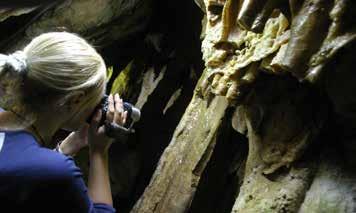
By complete accident a local found a stone in the forest which, when he put in a fire, transformed into a glowing lump. His dis covery soon led to the opening of the biggest black coal mine in Serbia (1854). The mine of Senj has been out of operation for a long time now, but the Coal Mining Museum serves as a good reminder of the glorious times of its rise and existence.
Paraćin is the glass capital of the Balkans. “The Wind Orches tra” of the Serbian Glass Factory is known for their unique oneof-the-kind products and the secret of making two-layer crystal with semi-precious stones.
• A weekend at the picnic spots of Grza and Sisevac
• Mountaineering on the paths on the Beljanica and Južni Kučaj mountains
• Visiting Resava Cave
• Lisine – a trip to Veliko vrelo and the waterfalls of Veliki buk and Prskalo

• A walking tour to the medieval town of Petrus
• Relaxing stay in the villages in the vicinity of Despotovac
• Fishing in the spring and the lakes of Grza
• The Dani vina wine festival, March, Paraćin
• The Days of the Serbian Spiritual Transformation, August, Despotovac
• International Knights Festival “Just Out”, August, Manasija Monastery
Organisation of Paraćin
of Despotovac
• The wooden church of Pokajnica and the Church of St. George

• Radovanjski Lug Memorial Complex
• Trg Mare Resavkinja (Mara of Resava Square), Svilajnac
• Natural History Centre of Serbia, Svilajnac
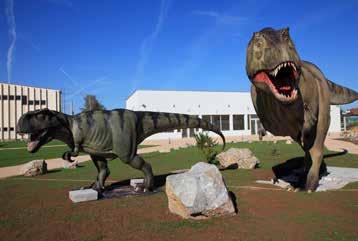
• The Memorial House of Stevan Sinđelić, Grabovac
• Mućkalica (a stew of meat and vegetables) cooked in the Mo rava way with a small glass of Bardaklija plum brandy
• Resavski kotlić (Resava fish soup cooked in a traditional kettle) and a glass of Krnjevo wine
• Rest in the ethno-village of “Moravski konaci”
• Visiting the sights of Velika Plana on the tourist train
• A short break in the traditional atmosphere of Vodenica, Velika Plana
• Recreation at the Sports and Tourism Centre “Svilajnac”
• “Svi-Bajk” free bike rental programme of the Natural History Centre
• Fishing on the Great Morava river and the artificial lakes
• Days of the Leader Karađorđe, July, Velika Plana
• Days of Sinđelić, May, Svilajnac
The Ktetors’ (founders’) records tell us that the Koporin Monas tery was built after the Battle of Ankara (1402) in which Despot Stefan Lazarević fought on the side of Ottoman Sultan Bayezid. The Ottomans suffered defeat – a milestone in the further his tory of the Serbian Despotate. The complex comprises the Church of St. Stefan, bell steeples and residences. During excavations, a grave was found which almost certainly belonged to Stefan.
In 1817, Duke Vujica Vulićević decapitated his godfather Karđorđe, the great leader of the First Serbian Uprising. Despised by the people, he built a wooden church which people called Pokajnica (Repentance Church) in order to redeem himself. In Radovanjski lug, where the cottage in which the leader was decapitated once stood, his great-grandson King Alexander I Karađorđević built the Zahvalnica Church (Gratitude Church). That treacherous mur der left a deep-rooted stain on the later history of Serbia.
The truth and the legend of the brave acts of the girl Mara have, as the centuries passed, became a cult topic of the Resava region. The monument dedicated to Mara of Resava was built in 1926 in honour of warriors from Svijalnac who gave their lives in the bat tles from 1912 to 1918.

The Natural History Centre of Serbia in Svilajnac has an exhibi tion space split into halls showcasing different themes, from the geological ages, the diversity of the living world, extinct plants and animals, flying reptiles and the life of the mammals. The Dino Park is a big attraction out in the open and contains replicas of dino saurs, a scale model of a volcano with “hot” lava and small lakes where showing the evolution of our planet.
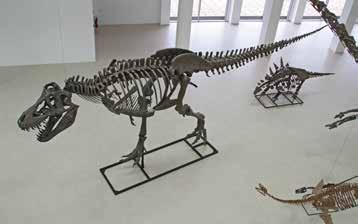
• Smederevo Fortress
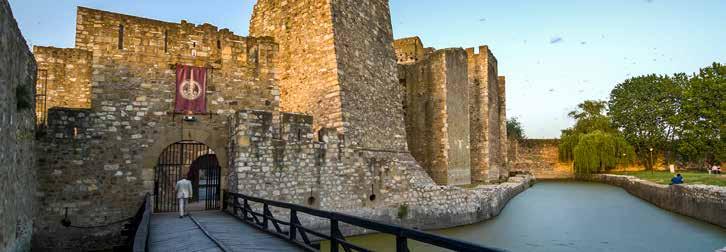
• The main town square and the Church of St. George
• The Town Museum and the Monument to the Victims of the Tragedy of the 5th of June
• Holiday home of the Obrenović dynasty – the “Zlatni breg” (“Golden Hill”) villa
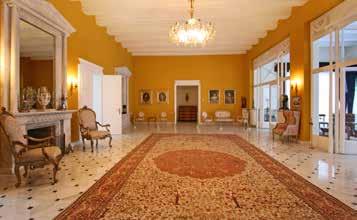
• The Church of the Dormition of the Holy Mother of God
• The old bazaar and the National Museum, Smederevska Palanka
• The wooden church and the Church of the Holy Transfiguration, Smederevska Palanka
• Pike-perch with a glass of Smederevka wine
• Vine-leaf rolls – sarme
• Pogača bread made in Azanja and “Karađorđe” mineral water
The town of Smederevo (15th century) was built by Serbian Des pot Đurađ Branković as his capital. In its final form, it was a huge 25-tower fortress on the Danube! The fortress was built fast as the Turkish conquerors were closing in, but there was not enough stone, so builders resorted to using old tombstones in the con struction. This outraged the people and created a belief that his tyrannical wife Irena, who was remembered as ‘Damned Jerina’, was the one to blame. The fall of Smederevo into the hands of the Ottomans in 1459 was the moment the independent Serbian state ended.
A 300-year-old mulberry tree is a unique sight in Smederevo. On 8th November 1805, under this tree, a Turkish commander handed over the keys to the town to Great Leader Karađorđe. And so, for the second time in its history, Smederevo became the symbolic capital of Serbia.
The loose ground and hillocks and the banks of the Danube and Great Morava rivers are ideal for growing grapes. The most fa mous variety of grape found in those winegrowing hills is Sme derevka, and the most important wine festival takes place in the autumn.

The mineral water of Palanački kiseljak has been drunk since the times of the ancient Romans. The beginnings of the development of Kiseljak are linked to Prince Miloš Obrenović, who wrote in 1834 to his doctor asking for six jugs of this water to be brought by the postman (surudžija). The bottled water from this spring is called “Karađorđe” today.
• Visiting the Wine Town (Vinski grad) in Smederevo
• Exploring the wine routes in Smederevo
• Recreation at the Jugovo picnic spot
• Swimming in Šalinac Lake
• Rest and fishing on the Kudreč Lake
• Recreation at the Mikulja Forest Tourist Centre
• Smederevska jesen (Autumn in Smederevo) festival, September
• Fortress Theatre Festival, July, Smederevo
• Azanja pogača bread festival, August, Azanja
Looted and destroyed in the middle of the 5th century, Vimina cium, the capital of the Roman Province of Upper Moesia, lived underneath the ploughed soil for almost 2,000 years. What was discovered after the excavation of the “forgotten town” amazed the world, especially the frescoes and portraits of the Mauso leum, which are considered forerunners of Byzantine portrait art. Probably the most beautiful and oldest of Christ’s monograms was painted in one of the tombs.
Reconstruction of a scene of life in Viminacium, 2nd century
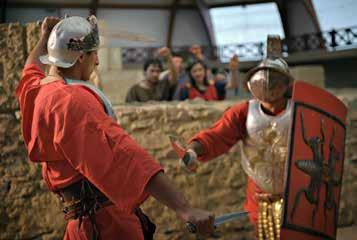
• The Okružno Zdanje building and the town centre of Požarevac
• The National Museum and the Tulba ethno-park
• The Gallery of Milena Pavlović Barili
• Viminacium Archaeological Park
• Ljubičevo Stud Farm and Horse Stables
• The Rukumija and Vitovnicа monasteries
• Sheep cheese and proja corn bread with greens
• Mixed meat
• An outing to and walk in Čačalica Memorial Park
• Riding in a horse-drawn carriage at the Ljubičevo Stud Farm
• Rest in the ethno-village of Bistrica and the Homolje lodgings
• A weekend at the Aqua Park and the swimming pools at Ždrelo Spa
• Fishing and a break on Busur Lake
• An outing to “Trest” on the slopes of the Homolje mountains and mountaineering on the paths on Vukan and Ježevac
• Equestrian Games of Ljubičevo, September, Požarevac
• The International Biennale “In the Light of Milena”, Požarevac
• The Bačijada shepherd festival, May, Petrovac na Mlavi
Milena Pavlović Barili, a great Serbian female painter, surmised her poetics in one letter she sent to her mother: “In my imagination, our talks about the water fairy of the river, which you were telling me about, became one with Valerius’ poems, and the broken Ro man sculptures and sarcophagi, which I used look at with excite ment and admiration at the archaeological sites near Požarevac, led me to the visions of Botticelli and De Chirico”. In Milena’s birth house in Požarevac, her precious legacy is exhibited.

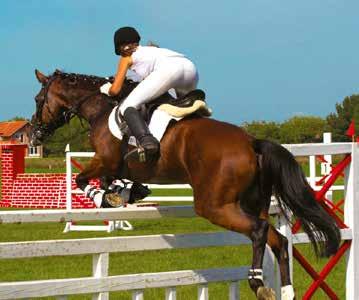
Ljubičevo Stud Farm, which Miloš Obrenović built as his estate (in 1853), is a fantastic attraction in Požarevac. The estate was given its name by Prince Mihailo, in remembrance of his mother, Princess Ljubica. At the beginning of the 20th century, the horsebreeding stables were known throughout Europe, which is evi denced by the Trophy Hall and the gold-engraved names of the champion horses Ljubičevac, Kastor and Remoz. The all-round competition of Ljubičevo – the jockey competition which involves sabre cutting, archery, javelin and mace throwing.
INFO Visit Požarevac www.togp.rs
Tourism Organisation of Petrovac na Mlavi www.topetrovacnamlavi.com
• The town centre of Kučevo and the Church of Holy Ascension
• The summer residence of King Aleksandar Karađorđević I, Neresnica
• Gornjak Monastery and Trška Church

• The centre of Žagubica and the Church of the Holy Trinity
• Homolje cheese and lamb in milk
• Vlach pogača bread and “plaćinta” pancakes
• Homolje honey

• A cave tour: Ceremošnja and Ravništarka
• Gold panning in the river Pek
• An outing to the viewpoint of Jelena stena
• A weekend at the Rudnik Hotel, Kučevo
• Mountaineering on the paths in Homolje and Zvižd
• Rest and swimming in the Krupaj springs
• A break at the Mlava spring
• Fishing and canyoning in Gornjak Gorge (Gornjačka klisura)
• Homolje Motifs celebrations, May – June, Kučevo
• Homolje Springs Festival, June, Žagubica
INFO Tourism Organisation of Kučevo www.tokucevo.org
Tourism Organisation of Žagubica www.tozagubica.rs
In the 1930s, an excavator for digging gold was brought to Neresni ca. It was bought by an enterprise the majority owner of which was King Alexander Karađorđević. By 1955, when it was sent to scrap heap, the excavator had dug about seven tons of pure gold. Roman Emperor Hadrian had gold, silver and iron mines in the Kučevo re gion. The “Kraku Lu Jordan” archaeology and metallurgy complex near the village of Brodica was an important metallurgy centre.
Ceremošnja Cave is an excellent example of the richness of cave decorations. The beautiful hall reminds visitors of the Colosseum, and for that reason it was given the name ‘Arena’. The symbol of Ceremošnja is a most beautiful pillar called ‘On Eternal Sentry’.
Gornjak Monastery (14th century) is the legacy of Prince Lazar. It was built in the Mlava river canyon on a narrow plateau at the foot of a steep cliff called Ježevica. The famous travel writer Felix Kanitz wrote this about his impressions of this place: “We stopped for a while as if charmed by the luxurious idyll of this landscape where Serbian hermits lived.” According to legend, St. Gregory of Sinai practiced asceticism in the chapel of Saint Sava, which is built in the vertical rock above the monastery.
The Mlava Spring is the deepest spring in Europe. It has the form of a lake and is located in a natural amphitheatre surrounded by woods. This crystal clear, emerald spring is the venue of the tra ditional festivals of the Vlachs.

• Ram Fortress and Old Bazaar, Veliko Gradište
• Golubac Fortress

• Nimnik Monastery
• Tumane Monastery and the Hermitage of Zosim of Sinai
• Gradištanac beans
• Golubac pike-perch and riblji kotlić (fish soup cooked in a traditional kettle)
• Grilled Vlach boiled cheese
• Rest at the hotels and villas of Silver Lake (Srebrno jezero)
• A weekend at the Silver Lake Aqua Park and cruising down the Danube river
• Swimming and sports fishing on Silver Lake and the Danube
• Sailing and panoramic sightseeing of Golubac from a boat
• Walking on the “Lilac and Smoketree Path”
• Bathing on the beaches in the Usinje and Vinci settlements
• Riding a bike on the EuroVelo 6 route
• Days of Carevac, July, Veliko Gradište
• The International Festival of Tourist and Ecological Films “Si lafest”, August – September, Veliko Gradište
• The Danube Fair, July, Golubac
While traveling around these territories, Turkish travel writer Ev liya Çelebi wrote down a folk tale about the origin of the name of Ram Fortress, which says that Sultan Beyazid came here and spread his prayer ihram – a sacred garment, and sat down and said: “Here, where this ihram is, build a fortress for me.”
The most significant tourist attraction Veliko Gradište has to offer is Silver Lake. In the afternoon, when the sun begins to set behind the Carpathian Mountains, millions of small scintillas make the surface of the water sparkle, creating a silver reflection.
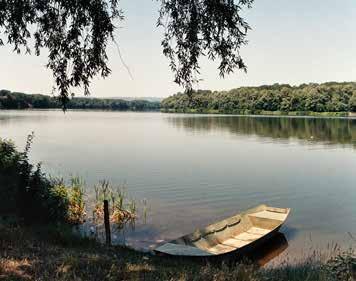
The Danube is as large as a sea in Golubac. The entrance to the gorge is guarded by the medieval fortress of Golubac (14th cen tury) – a symbol of medieval wars and turmoil on the Danube border. Its tall towers and ramparts slope right down to the bank of the river, and its octagonal Hat Tower is the trademark of the attractive tourist area with a visitor centre and guide service.
Zawisza Czarny, a great national hero of Poland, heroically died in the battle for Golubac Fortress in 1428. He commanded a unit of Polish knights, Vlach horsemen and Italian archers, defending the retreat of King Sigismund of Luxembourg.
Golubac Fortress finally fell into the hands of the Ottomans in 1458. Mahmud-Paša Andjelović, the first Ottoman Grand Vizier of Serbian origin. He quickly constructed his endowment – a mosque and hammam bath. The remains of the Turkish bath, as well as of the antiquity “Roman House”, can be seen today in the Archaeo logical Park on the outskirts of the Fortress.
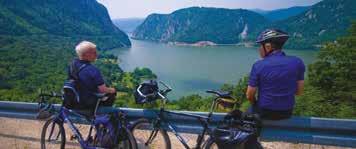
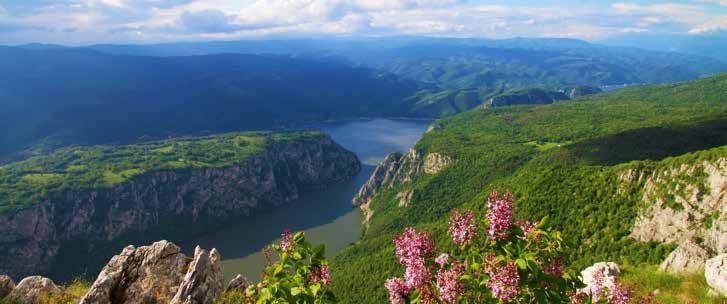
• The Lepenski Vir archaeological site

• The atmosphere in the town of Donji Milanovac
• The town centre and the Archaeological Museum of Đerdap, Kladovo
• The Hydroelectric Power Plant Đerdap I
• The Roman Diana and the Turkish Fetislam fortresses
• Tabula Traiana and the remains of Trajan’s Bridge
• Poreč fish soup (riblji kotlić) and fried catfish
• “Dušana Dunava” wine and Vlach kačamak (maize porridge) called “mamaljiga”
• Mountaineering on the paths in the Đerdap National Park and on Miroč mountain
• Boating and nautical sailing on the Danube

• Cycling on the EuroVelo 6 bike route
• Visiting Rajko’s Cave (Rajkova pećina), Beli izvorac (White Small Spring) and the Valja prerast natural stone bridge
• A weekend in the hotels and ethno-complexes
• Bathing on the sandy beaches of Kladovo and Brza Palanka
• The Golden Bućka of Đerdap catfish catching competition, August, Tekija
• Ethno-Festival, July, Kladovo
The Iron Gate Famous researcher of the underwater world Jacques Cousteau measured the depths of Đerdap – at Gospođin vir (Lady’s Whirl pool), the river is 90 metres deep! Not only is the Đerdap Gorge the deepest but it is also the biggest breakthrough river of the Old Continent. The Romans named it the Iron Gate. The name Đerdap used in the Serbian language today originates from the Old Persian word girdap, which means a whirlpool.
Lepenski Vir is the oldest urban settlement in Europe! This an cient culture, whose people knew of geometry more than 9,000 years ago, was discovered by a “lucky” archaeologist, Professor Dragoslav Srejović. The monumental stone sculptures of fishlike deities from the Danube Terrace amazed the world: “The Progeni tor” is considered to be the first portrait in the history of art.
In many ways, the Đerdap abounds in superlatives: the most beauti ful National Park of Europe, the biggest natural science and archae ological museum in nature and the oldest geological heritage. From the viewpoints of Veliki and Mali Štrbac, one can enjoy the most un believable views of the gorge and the powerful river below.
The Roman border road, built with great effort through the wil derness of the gorge, was flooded when the dam of the hydro power plant opened. Today, this feat is testified to by the famous Traiana Tabula memorial plaque. One of the masterpieces of the famous architect Apollodorus of Damascus is the stone bridge over the Danube, which historians say was “the longest bridge in the world for one thousand years”.
•
•
• The Museum of Mining and Metallurgy, Bor
• Caffe Jama, 11th Horizon of the Bor Mine
The Prince Miloš Residence building and exhibition, Brestovačka Spa
• The old town centre of Negotin and the Church of the Holy Trinity
• Stevan Mokranjac’s House and the Museum of Hajduk Veljko
• The Vratna and Bukovo monasteries

• The wines of Negotin: red tamjanika, Beaujolais, gamet...
• Game specialities
• Visiting the Zoo in Bor
• A weekend at Borsko Jezero Lake and Brestovačka Banja Spa

• Mountaineering on the paths on the Deli Jovan and Stol mountains
• Visiting Lazareva Pećina (Lazar’s Cave) and natural stone gate of Vratnjanske Kapije
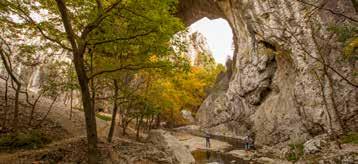
• Outing to and bathing in the Mokranjske Stene lake
• Visiting the stone wine cellars of Rajac and Rogljevo
Serbian industrialist Georg Weifert, mining expert Felix Hoff mann, a German from Banat, and Czech engineer Franja Šištek discovered a treasure which they were not originally hoping to find. They were looking for gold but instead they found an abun dance of copper. Concessions for exploitation were given to the French, and that is why today it is possible to see the buildings such as the Directorate of the French Society of the Mines of Bor and the preserved area known as “The French Colony”.
“He was first for his heart and bodily prowess not only in Ser bia but, we can freely say, in the whole of Europe. In the times of Achilles and Miloš Obilić, he would have certainly been their friend,” Vuk Karadžić wrote of Hajduk Veljko. He died in 1811 de fending Negotin. Legend has it that he had more women than the number of Turkish heads he cut off, but one of these women won him over: the tiny but brave Čučuk Stana from the village of Sikole near Negotin.
Wine cellers (pimnice) of Rajac
•
of Brestovačka Banja Spa, August
• The Days of Mokranjac, September, Negotin
The wines of the Negotinska Krajina region used to be popular throughout Europe and Russia, and Austria-Hungary even had a special consulate for trading in the wines of Negotin. As early as the 17th century, the winegrowers of this region began building their pimnica where they kept wine in stone cellars. The beautiful ambi ence of the wine settlements of Rajac, Rogalj, Smedovac, Štubik and Bratujevac have been well preserved and visitors enjoy them today.
A famous composer born in Negotin, Stevan Stojanović Mokranjac, dedicated most of his work to Orthodox spiritual music. His Liturgy and liturgical Cherubic Hymn are considered the most beautiful works of Serbian choral music. His Potpourri are also famous collec tions of songs and music with folklore motifs.
Tourism Organisation of Bor www.tobor.rs
Tourism Organisation of Negotin www.toon.org.rs



• UNESCO heritage – Felix Romuliana imperial palace, Gamzigrad
• The Felix Romuliana Collection, the Zaječar National Museum
• Endowment of Nikola Pašić
• Radul-Bey’s Residence (konak) and Turkish water mill
• The Grlište and Suvobor monasteries
• Gamzigrad Hydroelectric Power Station, Gamzigradska Spa
• The “Old Prison” Museum of the Timok Rebellion, Boljevac
• Kačkavalj yellow cheese from Krivi Vir and kiselo mleko (cultu red dairy product)
• A pint of the local Zaječarsko beer
• Timočka salad and Rtanj tea
• Recreation in the Kraljevica park forest
• Mountaineering and mountain biking on the paths on Rtanj mountain
• A break in the Julius Minh family’s park forest
• A weekend at the ethno-centre “Rtanj Balašević”, at the hotel Ramonda and at Gamzigradska Spa
• A visit to Bogovinska Cave
• The Black-river Region in Song and Dance, June, Boljevac
• The Gitarijada Guitar Fest, June, Zaječar
• The Days of Zoran Radmilović, Theatrical Encounters, October – November, Zaječar
The Gamzigrad-Romuliana complex was built by Roman Emper or Galerius, the successor of Emperor Diocletian. As regards its reaches, the imperial palace is an artistic masterpiece of the late antiquity. The Magura Hill within Romuliana has been a highly re spected place since prehistoric times. At that holy place, Galerius and his mother Romula were buried, which, according to legend, transcended them to the constellations of the gods.
“The Black River Basin, especially its mountainous frame, is one of the most beautiful landscapes in the Balkan Peninsula. Mount Rtanj greatly contributes to such an impression by peacefully ris ing from a broad foundation, naked, gigantic, and ending with the almost perfect cone of Šiljak peak”. There are numerous leg ends about Rtanj, as well as stories about aliens, secret forces and therapeutic powers.
The people of Zaječar say they were lucky that Velimir Đorđević, a master of the Pirot pottery school, moved to their town. Crafts and works of art were created here in his workshop. Velimir imagined and sculpted in clay the world of shepherds, horsemen, fairy-tale beings and Koledari masks.
The edifice of the old prison in Boljevac, where rebels were being imprisoned during the Timok Rebellion (1883), has been turned into a museum preserving the memories of that rebellion by the representatives of the People’s Radical Party against the govern ment of King Milan Obrenović. The government responded by de claring a state of emergency and introducing a court martial. This event is remembered as the “month of death”, the most tragic pe riod in the history of the Timok region.
At the end of 19th and the beginning of the 20th centuries, the spa was a place where Serbian noblemen and bohemians met. It was named after the medieval fortress of Soko Grad. The oldest spa building and the one in which the town takes prides is the old Turkish hammam, built on the two thermo-mineral springs which had been used since Roman times.
There are many testaments to the beneficial influence of the spa. One such testament was left by the famous Ivo Andrić: “I do not know which natural forces exist in the spa, but I do know that after 15-20 days of my stay in Sokobanja Spa, I work in Belgrade as if I were born again.” An old comedy writer, Branislav Nušić, wrote his famous rhyming motto of this spa, in which he says people come to Sokobanja old and leave feeling young again.
• The first view of the town taking a walk along Sokobanja’s promenade
• Miloš’s Residence (Milošev konak) and the Church of the Holy Transfiguration
• The Homeland Museum and Soko Grad Fortress
• Suite of Nobel Prize Winner Ivo Andrić, Moravica Hotel
• Ethno exhibit and site “Latin Town”, village of Vrmdža
• The town centre and the Church of St. Nicholas, Aleksinac
• Holy Trinity Temple, Gornji Adrovac
• Sokobanja cheese and lamb
• Kajmak (similar to clotted cream) and kiselo mleko (cultured dairy product) of the Morava region
• Aleksinac ćevapčići (grilled minced meat kebabs)
An isolated rock in the picnic spot of Očno is known as the ‘Stone of Love’. Legend says that Hajduk Veljko and his wife Čučuk Stana vowed to love each other there, and it is believed that any couple who climbs the rock will be in love with each other until the end of their lives. The air circulates in a special way above Očno and the waterfalls of Ripaljka, the highest to be found in Serbia, are nearby.
The Temple of the Holy Trinity near Aleksinac was built on the place where, fighting for Serbia’s freedom, Russian colonel Nikolay Raevsky was killed. Raevsky’s personality served as Lev Tolstoy inspiration for the character Count Vronsky in his novel “Anna Karenina”.
• Wellness programmes at the Turkish Hammam and Sokobanja Spe cial Hospital
• A weekend at Aqua Park “Podina”, Sokobanja
• Walking the fitness trails and swimming at the beaches of the Mora vica river
• Trips to the picnic spots of Lepterija and Očno, and the Vrelo Borići springs
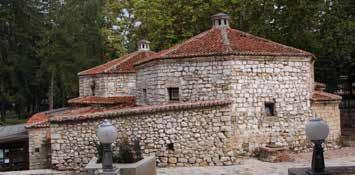
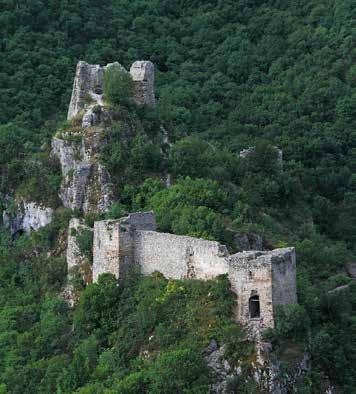
• Boat trips and fishing on Bovran Lake
• Mountaineering on the paths on Ozren, Rtanj, Bukovik and Devica mountains

• Rest in the villages around Sokobanja and Aleksinac
Tourism Organisation of Sokobanja www.sokobanja.rs
Tourism Organisation of Aleksinac www.turizamzavasinas.com
• The Final of the First Accordion International Festival, August, Sokobanja
• Green Heart Fest, third weekend in July, Sokobanja
• Cultural Summer in Sokobanja Spa, June-September
• The “Na Moravi vodenica stara” Ethno-Festival, July, Aleksinac
•
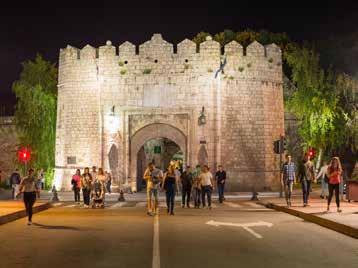
• Trg kralja Milana (King Milan Square) and the city centre
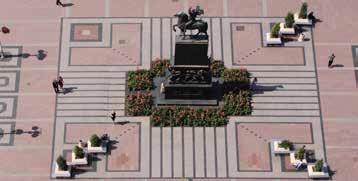
• Niš Fortress
The old bazaar, aka Tinker’s Alley – Kazandžijsko sokače (also known as Coppersmith Alley)
• The Archaeology Hall of the National Museum
• The archaeological site of Mediana
• The Skull Tower (Ćele kula) and the monument to the Battle of Čegar
• The Red Cross Concentration Camp (Logor Crveni Krst) and the Bubanj Memorial Park
• Niš barbecue (roštilj) and Niš burek (filled phyllo pastry)
• Sarmice (stuffed cabbage rolls), prebanac (baked beans) and other meals cooked in earthenware dishes
• Wellness relaxation in Niška Banja Spa
• Mountaineering on the paths on Suva Planina mountain
• A trip to Bojanine vode (Bojana’s Waters)
• Jeep safari: Suva Planina mountain, Great and Small Jastrebac mountains
• Free climbing in the Jelešnica gorge and rafting in the Sićevo gorge
• Paragliding
• Nišville Jazz Festival, August
• The Filmski susreti film festival, August
• The Dani bureka burek pastry festival, August–September
Emperor Constantine the Great was born in ancient Naissus, to day’s Niš. He is remembered in history as a ruler who fundamen tally changed the world – he built Constantinople, and with the Edict of Milan, he formally allowed the religion of the Christians.

The traces of Constantine’s time are visible at the site Mediana (4th century), where, amongst other things, once stood the imperial summer house, testifying to the wealth and glory of imperial Naissus.
The fortress (18th century) is the symbol of the city and is one of the most beautiful and best-preserved edifices of Turkish military architecture in the central Balkans. The Antique Street, the Lapi darium, the Old Hammam and the Arsenal are just a small part of the sights that form the treasures of Niš Fortress.
At the entrance to the liveliest part of the city, Tinkers’ Alley, there is an unusual monument: a tavern table where two men are cheerfully talking to each other and a hunting dog. They are Ser bian writer Stevan Sremac and Hunter Kalča, the writer’s literary character, who entertains the people by telling them about his imagined heroic deeds. Despite not being real, Kalča is the fa vourite character of the city of Niš. He welcomes and say farewell to those who come to visit this former Turkish coppersmiths’ ba zaar which is today lined with cafes, bars and restaurants.
The Serbian revolutionary army conquered the Čegar Hill in 1809, led by their commander, Duke Stevan Sinđelić. Realising that he would not be able to keep the larger Turkish army at bay, he de cided on a heroic act: he lured them into position and then blew himself and everybody else up. When the commander of the city learned about the event, he ordered for the heads of the killed Serbs to be collected and built into a tower. The Skull Tower, i.e. Ćele kula, is a unique monument of brutal revenge. Niš is also the only city in Serbia that has preserved the remains of the former fascist concentration camp in the Red Cross (Crveni Krst) area of the city.
• The old bazaar (Stara čaršija) in Knjaževac and the stone bridge
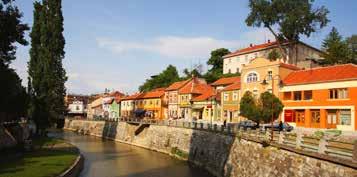
• The Homeland Museum of Knjaževac
• The Town Museum – Aca Stanojević’s House
• The Memorial Park dedicated to the soldiers who fought in the wars of liberation
• The Archaeological and Ethno Park in Ravna
• The Church of the Holy Mother of God and the Holy Trinity Monastery
• Lamb and kačkavalj yellow cheese from Stara Planina
• A glass of the local Knjaževac Vranac wine or rose wine
• Belmuž made with corn flour and Svrljig cheese
• Exploring the wine routes of Knjaževac
• A wellness weekend at the “Stara Planina” Hotel
• Skiing at the ski-centre of “Babin zub”
• Mountaineering on the paths on Stara Planina Mountain
• Stay in the mountain villas and rural village households
• Stay in the villages surrounding Knjaževac and Svrljig
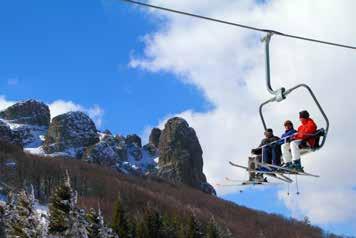

The dense forests, spacious pastures and picturesque villages leave their indelible mark on the landscape of Stara Planina mountain. The rocks of Babin Zub (Grandmother’s Tooth) lie 1758 metres above sea level, with one of the rocks having a different shape reminding those who see it of an old tooth. Especially interesting are the Bigar Spring valley, the highest peak called Midžor and the meanders of the Temštica river.
The stara čaršija (old bazaar) in Knjaževac, with its beautiful hous es painted in different colours and its small bridges on the Timok, is a feast for the eyes. The famous architect Le Corbusier visited Knjaževac in the beginning of the 20th century. Inspired by what he saw, he made a sketch of the town, and that sketch is today kept in the National Museum in Belgrade.
Stara planina - Babin zub
• Festival of the Culture of the Young of Serbia, July, Knjaževac
• A Prayer Under Midžorom, St. George’s Day, May, the villages of Vrtovac and Balta Berilovac
• The Festival of the Belmuž Specialty, August, Svrljig
Differing in their design and colours, traditional double-knit socks are prominent representatives of traditional folk art. The decora tions on the knitted socks are unique in the region of Knjaževac. Together with a rich collection of socks, the Homeland Museum also safeguards a unique album with drawings showing the skill of the knitting-women of the Timok region. That precious collection exists today thanks to spouses Svetozar and Vidosava Popović.
The village of Ravna near Knjaževac is home to an archaeological ethno park comprising three units: a museum of folk construc tions, the remains of the Roman fortification Timacum Minus and a museum of viticulture which serves select wines from eastern Serbia and western Bulgaria.
Centre for Tourism, Culture and Sport Svrljig www.kcsvrljig.rs
TIMOK WINEGROWING HILLS AND THE LUSH STARA PLANINA MOUNTAIN
•
The town centre and the old crafts quarter in Tijabara
• The Old Church and the Orthodox Cathedral Church in Tijabara
• The Ponišavlje Museum in the House of the Hristić Family
• The Pirot Fortress, also known as Momčilov Grad

• The Church of the Nativity of the Most-Holy Mother of God, Dimitrovgrad
• Monastery of St. John the Theologian – Poganovo
• Monastery of the Most-Holy Mother of God, the village of Sukovo
• Monastery of St. George, the village of Temska
• The lamb and ironed sausage of Pirot
• The kačkavalj yellow cheese of Pirot and the vurda dairy spe cialty of Lužnica
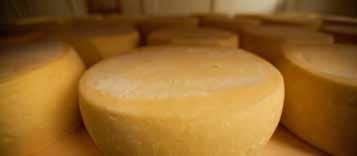
• Banica pie and broad bean pihtije (aspic) made in the Stara Planina mountain region
• Trips to Zavoj Lake, Temac, Sukovo, Poganovo
• Trekking and mountain biking along the gorge of the Temštica, the Rosomačka and the Visočica rivers
• Rafting and canyoning in Vladikine ploče (Bishop’s Plates) on the Visočica and the Temštica rivers
• Conquering the peaks of Stara Planina mountain: Babin Zub, Vražja Glava , Tri Čuke and Kopren
• Stay in the villages around Pirot and Dimitrovgrad
• Fishing on the lakes of Smilovo and in the Jerma canyon
• The Ironed Sausage Fair of Pirot, January, Pirot
• The International Festival of Folklore, August, Pirot

• The Fair of Agro-biodiversity and Rural Heritage, September, Smilovci, Dimitrovgrad
• The “Dani Caribrodske šušenice” smoked meat event, November, Dimitrovgrad
The colours, decorations and weaving patterns of the kilim (ćilim, traditional rug) of Pirot are considered the most beautiful accom plishments of kilim-making in general. The colours of the kilim are clear and harmonious. The decorations are always geometri cal in shape: a stylised bird, a flower, a flame, for example. At the Ponišavlje Museum, there is an extraordinary collection of Pirot kilims, which is a ‘must-see’, as well as collections of famous Pirot pottery and old jewellery.
The fortress is one of the symbols of Pirot. There is folk legend that associates the construction of “Kale” to the name Duke Momčilo. According to one story, Momčilo was Lazar’s brave knight, and ac cording to another, he was the commander of hajduks (outlaws). From one generation to another, another legend is passed down that says that the famous hero of the Battle of Kosovo, Miloš Obrenović, lived in the fortress. The town was named after the Greek word Pirgos – meaning “towers”, because this was where sentry towers had been built on the main road since Roman times.
One of the most interesting holy places in Pirot is the Church of St. Peter and Paul (13th century). There is a fresco in the church, which depicts a very young and bald Jesus. The fresco of St. Chris topher in the Church of the Monastery of the Most-Holy Mother of God in Sukovo is also unique, depicting the saint with a don key’s head.
Everything is built of stone in the village of Gostuša on Stara Planina mountain: houses, roofs, chimneys and fences. In addition to the original method of construction, the village also preserves highland customs and the spirit of bygone times. The conserva tion and revitalisation of Gostuša project received a prestigious European award for cultural heritage.
Tourism Organisation of Babušnica www.babusnica.rs
THE HEART OF THE BALKANS IN THE COLOURS AND THE PATTERNS OF KILIMS
Procopius, a historian and contemporary of Emperor Justinian I, recorded the building of this palace in the Emperor’s hometown of Illyricum. For a long time, nobody knew where the emperor’s new town “had disappeared”. The story about the discovery of the magnificent urban space began as far back as 1880 when “The Lost Town in the Valley of the Deserted River” was published. Af ter many years of research what the archaeologists discovered amazed the world: an archbishop’s basilica, a court in an Acropo lis, churches, public buildings, wide streets and mosaics. Justini ana Prima, or Empress’s Town (Čaričin Grad), is a unique architec tural gem of its time and a candidate for entry on the UNESCO List.
• The Archaeological site of Iustiniana Prima – Čaričin Grad

• The National Museum, Leskovac
• The Ethnological Exhibition in the Town Hall and Šop-Đokić’s House
• The “Odžaklija” (Chimney) Church and the Cathedral Church of the Holy Trinity
• The Museum of the Textile Industry, the village of Strojkovac
• The monasteries in Jašunja: St. John the Baptist and the Holy Mother of God
• The Church of St. Petka with konak, the village of Rudare LOCAL SPECIALITIES
• Leskovački voz (‘Leskovac train’) mixed grilled meats, ajvar salad (pepper-based relish)

• Leskovačka pljeskavica (local Leskovac version of a spicy grilled meat patty) and mućkalica (grilled pork with a spicy pepper and tomato stew)
• “Sprža” – southern duvan čvarci (tobacco-shaped pork crac kling ‘crisps’)
On the slopes of the Leskovac valley, on Hisgar Hill, a large num ber of buildings and archaeological objects bearing witness to life over seven millennia were discovered. A fantastic discovery from this site is the rustproof ‘Turović needle’ made of iron almost 100% pure.
The Vučje hydropower plant is inscribed on the list of precious in dustrial heritage. The power of the waterfall of the Vučjanka river was “transformed” by Siemens generators from 1903. From that year to now, the hydropower plant has been operating without interruption! Above the plant, there are the remains of a fortress called Skobaljić-grad by the people. Legend says that the fortress is named after Nikola Skobaljić, the ‘invincible duke’ (15th century).
The region of Leskovac is known for peppers. In early autumn, all the villages abound in red from the peppers hanging everywhere. The most picturesque village is Donja Lokošnica, which is adorned ‘from head to toe’ in strings of red peppers.
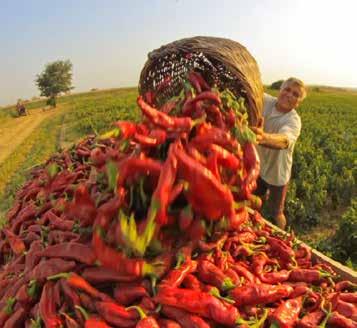
• Rest at the hotel “Pašina česma”
• Trekking tour along the canyon of the Vučjanka river to Skobajlić-grad
• Mountaineering on the paths on Radan, Kukavica and Babička Gora mountain
• Weekend at the “Teodora” visitor centre, Lebane
• Rest at Hotel “Gejzer”, Sijarinska Banja
• The Leskovac Roštiljijada Grill Festival, September
• Leskovac Summer and Carnival, June-July
• Summer in Bojnik, July, Bojnik
• International Festival of Folklore, August, Lebane
• The Geyser Nights, August, Sijarinska Banja
Tourism Organisation of Leskovac www.tol.rs
Tourism Organisation of Bojnik www.turizam.bojnik.rs
Tourism Organisation of Lebane www.iustinianaprima.lebane.org.rs
Tourism Organisation of Medveđa www.tomedvedja.org.rs
• The Monastery of St. Nicholas and of the Holy Mother of God, Kuršumlija
• The town centre – “Korzo” (“Promenade”) and the Okružno Načelstvo building, Prokuplje
• Hisar – Prokuplje Fortress and the Church of St. Procopius
• The Toplica National Museum and the Pločnik archaeology site
• The Ajdanovac Monastery, Lazarica Church and the Church of St. Mina
• House of Rade Drainac and the Tomić ethno-house, Blace
• Lamb and veal cooked under a bell-shaped metal lid (ispod sača)
• Pie ispod sača with a pint of “Prolom” beer
• A glass of Prokuplje wine and dumplings with Blace plums
• A visit to Đavolja Varoš (Devil’s Town)
• A wellness weekend at Hotel “Radan”, Prolom Banja Spa
• Rest in the hotels “Kopaonik” and “Jelak”, Lukovska Spa
• Hiking the fitness trails in Prolom Banja Spa and Lukovska Banja

• Swimming in Bubličko Lake
• Visiting the astronomical observatory on Vidojevica mountain
• Visiting the paleontological site “Prebreza”, Blace
• The International Devil’s Town Photo-Colony, October, Kuršumlija
• The Day of the Saint Patron of the Town – St. Procopius, July, Prokuplje
• Days of Plums, August, Blace
The monasteries of St. Nicholas and the Holy Mother of God in Kuršumlija are amongst the first endowments of Stefan Nemanja, the founder of the Nemanjić Dynasty (12th century). In 2018, a whole 850 years had passed since the establishment of the first capital of Serbia on the soil of today’s Kuršumlija.

Between the forested slopes of Radan there stands a magnificent “petrified” colonnade of statues made from earth, from the un imaginably distant Oligocene period, that jut upwards towards the sky from a sparsely vegetated “stage”. Two hundred and two mysterious figures with stone “caps” were given the name Đavolja Varoš (Devil’s Town). Legend says that these figures are wedding guests who have been turned to stone by the Devil himself. The ancient “small town” is a sculpture of nature and a place of ex traordinary beauty.

There are an incredibly large number of therapeutic springs flow ing from the depths of Radan and Kopaonik. The Prolom, Lukovs ka and Kuršumlijska Spas were built on these springs. The Toplica river, after which the whole region is named, is itself a legend. The river was named after the abundance of warm springs along its 136-kilometre course! At the entrance to Prokuplje, the river hits the rock of Hisar and withdraws by circumventing the hill (socalled epigenetic valley), which is yet another miracle of nature.
The archaeological site of Pločnik is a synonym for the late Vinča culture. Research shows that it is probably the oldest metallurgy centre in the world, which covered the territory of an incredible 110 hectares.
Doctor Aleksa Savić, a tireless doctor treating ordinary people, bequeathed his property to Prokuplje. The edifice of his endow ment, “Savićevac”, is located on Hisar Hill today.
PROKUPLJE, BLACEProlom Spa Lukovska Spa Đavolja varoš (Devil’s Town), Kuršumlija
• Park oslobođenja (Liberation Park) and St. Prince Lazar Temple, Vladičin Han
• Monastery of the Assumption of the Most-Holy Mother of God, the village of Mrtvica
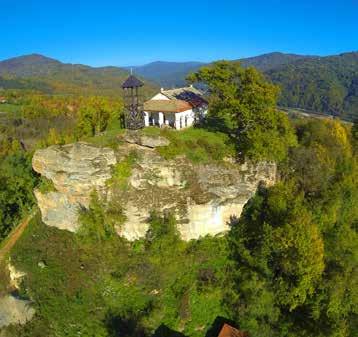
• The centre of Surdulica and the Church of St. George
• The centre of Bosilegrad and the Temple of the Nativity of the Most-Holy Mother of God
• Vlasina trout and riblji kotlić (fish soup cooked in a traditional kettle)
• Pita zeljanica pie with greens with sheep kiselo mleko (cultu red dairy product)
• Bosilegrad zelnik pie
• Stay at the hotels and apartments of Vlasina Lake

• Fishing on Vlasina Lake
• Water sports including sailing on the lake, rowing and kayaking
• Camping on the banks of Vlasina Lake
• Mountaineering and mountain biking on the paths on Čemer nik and Vardenik

• The Vlasinsko leto summer festivities, July, Surdulica, Vlasina Lake
• Overload, music festival, July, Vladičin Han
• International Children’s Easter Festival, Bosilegrad
Vlasina Lake formed on a spacious mountain peat bog. When the dam on the Vlasina river formed the lake, the peat lifted from the riverbed and formed big islands, which freely float carried by the winds. The peat moss “galleys” are a unique phenomenon and the trademark of Vlasina Lake. The colours of the water of the lake are also miraculous, with endless nuances of blue and green tones.
The most famous trumpet band in the Balkans comes from Vladičin Han. Today, Boban Marković and his son Marko are con sidered world famous musicians of the ethnic sound. Every year, excellent trumpeters from Vladičin Han, Surdulica, Bojnik and Vranje take part in the Vlasina summer event held each year.
Bora Stanković wrote the following kind words about the small town surrounded by the mountains: “Surdulica, intended to ac commodate anyone who wants to rest, refreshing them with its nature, is a central point between the wilderness of the Vlasina, the gentleness of Topli Do and the spacious meadows of Masuri ca…” There, King Alexander Karađorđević opened the Sanatorium for Pulmonary Diseases in 1921, where the main medicine was the refreshing air.
The First World War brought many evils to Surdulica. The region was occupied by the Bulgarians, and Surdulica was the place to where thousands of Serbian prisoners were deported. A large number of them, together with the native population, were killed in Surdulica’s torture chambers. Six years after the liberation, in 1924, King Alexander Karađorđević unveiled the Memorial Ossu ary and the Memorial High School in remembrance of the victims of those crimes.
Tourist Office of Surdulica www.tosurdulica.org
Centre for Cultural Activities, Tourism and Librarianship, Vladičin Han www.vladicinhan.org.rs
•
Famous writer Bora Stanković, the author of “Koštana” and “Nečista krv” (“Impure Blood”), revealed the untold world of Vranje. After his parents died, he stayed and lived with his father’s mother –Grandma Zlata. She was the one who told him a large number of stories and poems and from whom he inherited his gift of storytell ing. The birth house of the famous writer is in a picturesque street named after her – Baba Zlatina ulica, which exudes an atmosphere of bygone times.
The town centre and the Cathedral Church of the Holy Trinity
• The Bore Stanković Museum House
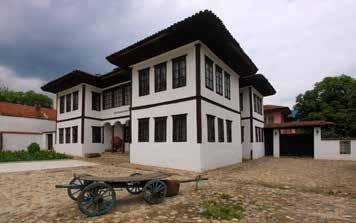
• The National Museum in the edifice of Pašin konak (Pasha’s Residence)
• The Prefecture of the District of Vranje building (Zgrada Načelstva okruga Vranjskog)
• The Church of St. Petka and the old hammam
• The White Bridge and Đerenka Fountain
• The “Markovo Kale” Fortress
• The Monastery of St. Prohor of Pčinja

• Đuveč tarhana stew with chicken
• Samsa pie served with kiselo mleko (cultured dairy product)
• Trljanica – pepper salad
• Mountaineering and mountain biking on the paths of Besna kobila mountain
• Recuperate in the Vranjska Banja Spa
• Stay at the hotel “Pržar”
• Skiing at the ski-centre of Besna kobila
• Stay at the Special Hospital “Bujanovačka banja” Spa
• The Days of Vranje, August, Vranje
• The Borina nedelja literary week, March, Vranje
• Bora’s Theatre Days (Borini pozorišni dani), October, Vranje
• The International Kolo Bujanovac Folklore Festival, July, Bujanovac
The melodic expression of Vranje became famous for the songs from Koštana. The Vranje dance is happy; each step carries a spe cial energy with it and is a real treat for those watching. The Vranje chochek and svita dances are well known. The extraordinary na tional trumpet orchestras are another special feature of the region.
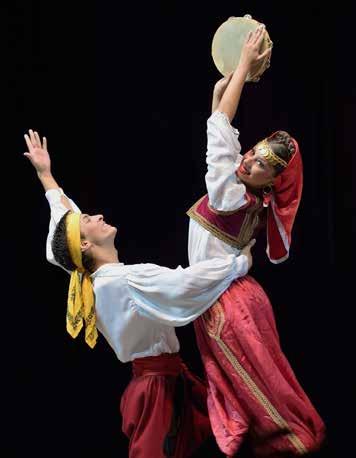
In the old lodgings of Raif-Bey Džinoli (1765), in the building of his luxurious haremluk, there is an exclusive restaurant and a function room for a diverse range of cultural events.
Legend says that the beautiful Turkish girl named Aisha and a poor shepherd called Stojan were killed by Aisha’s furious father – the rich and powerful Selim Bey. One day, having heard of the forbid den love, he went with rifle in hand after his daughter. He found them by the river and aimed at Stojan but hit his daughter by ac cident with the first bullet and killed the young man with the sec ond. Aisha’s last wish was for a bridge to be build right here where they suffered. The father granted his daughter’s wish and built the White Bridge in 1844.
• UNESCO Heritage – Our Lady of Ljeviš**
• The old bazaar and the stone bridge on the Bristrica
• Trg Šadrvan (Shadervan Square) and Sinan Pasha Mosque
• The Cathedral Church of St. George
• The Church of the Holy Saviour and the Dušanov Grad Fortress – Kaljaja
• Gazi Mehmet-Pasha’s Mosque and Hammam
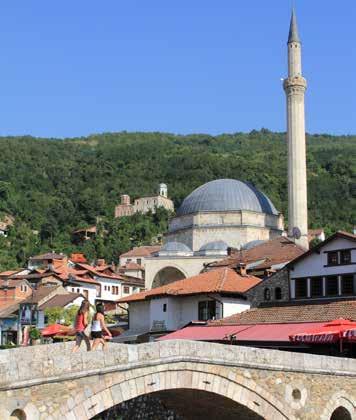
• The Monastery of Holy Archangels and the Hermitage of St. Peter of Koriša
• “toplija” pastry
• Šar cheese in brine
• Soup and pogača bread from Prizren
• A glass of Hoča wine
• Stay in the tourist settlement of “Brezovica”

• Skiing at the ski-centre of Molika
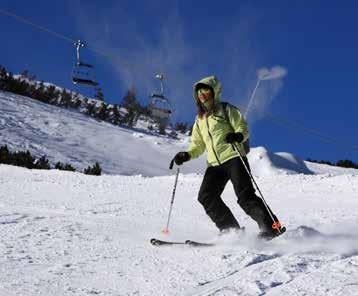
• Mountaineering and mountain biking on the paths on the Šar Mountains
• The Children’s Festival, June, Štrpce
Prizren is considered to be one of the most beautiful towns showcasing traditional Balkan architecture. Its picturesque ma halas (“neighbourhoods”) are worth seeing: Potkaljaja, Pantelija, Maraš, Terzi and Potok mahala. There are houses with oriel win dows and large, lush gardens dotted along winding, cobblestone alleys. Prizren is also the town of the terzi craftsmen - national costume tailors, tinsmiths, masters of weaving Prizren linen and the masters of Prizren embroidery – all of whom were well known throughout the Balkans.
The Church of Our Lady of Ljeviš (14th century) was built as one of the 40 endowments of King Milutin. The works of masters Nikola and Astrapa are considered masterpieces of Byzantine construc tion and fresco-painting. They were also admired by conquerors: “The pupil of my eye is the nest of your beauty”, are the words written in the Arabic language on the surface of the frescoes in Our Lady of Ljeviš by an unknown Muslim visitor.
The Šar Mountains National Park, with around one hundred peaks of more than 2,000 metres, is a mountain of an outstand ing and almost savage beauty. The Šar range is characterised by numerous glacial lakes. One of these that is especially beautiful is the Jažinačko Lake which is surrounded by a coniferous forest of Macedonian pines. The Šar Mountains are also a real museum of the living world in the open. It is home to 147 species of butterfly! It is also well known for a race of dog too, namely the Šarplaninac – the Yugoslavian shepherd dog, which are known for being brave and strong.
The Šar Mountains are frequently called the ‘imperial mountains’ due to the more than 30 churches and monasteries in the area. Amongst them, the most significant one is the endowment of Em peror Dušan the Mighty – the Monastery of the Holy Archangels (14th century) located in the canyon of Prizren’s Bistrica river.
THE COLOURFUL BALKANS AN OLD IMPERIAL TOWN AND THE BEAUTY OF THE ŠAR MOUNTAINS
The impressive monastery complex of the Patriarchate of Peć consists of four churches built between the mid-13th century and the end of the 14th century: the Church of the Holy Apostles, the Church of St. Demetrius, the Church of the Holy Mother of God Hodegetria and the Church of St. Nicholas. By the Church of Saint Apostles, there is a marble throne where Saint Sava and many other heads of the Serbian Church once sat. Today, there is a sis terhood which, together with the brotherhood of Visoki Dečani, is significantly supporting the survival of Serbs in Metohija.
The Holy King’s Home Visoki Dečani (14th century) was built by King Stefan Uroš III of Dečani, and his son Dušan. The temple is dedicated to the Ascen sion of Jesus Christ. As far as size is concerned, Dečani is the big gest sacred edifice of medieval Serbia. The church is decorated with luxurious stone ornamentation and frescoes with more than one thousand figures and scenes. UNESCO describes Dečani as an edifice that integrates the Byzantine tradition of the East with the medieval tradition of the West.
• UNESCO Heritage – The Patriarchate of Peć**
• UNESCO Heritage – Visoki Dečani Monastery**
• UNESCO Heritage – Our Lady of Ljeviš **
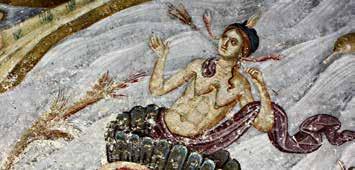
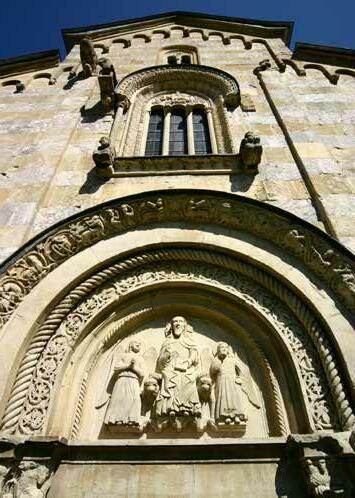
• The Monastery of the Holy Archangels
• The Churches of Velika Hoča and Dečanske vinice
• UNESCO Heritage – Gračanica Monastery**
• The monasteries of Banjska, Sokolica and Devič

• Poets’ Evening Service on the Day of St. Vitus, June, Gračanica
• The North City Jazz & Blues Festival, May-June, Kosovska Mitrovica
• Festival of the Assumption of the Virgin Mary, August, Leposavić
Gračanica (14th century) is the last in a series of the endowments of King Milutin. The Church is dedicated to the Ascension of the Most Holy Mother of God. The walls are made of chiselled stone with brick rows and decorative ornamentation and as such, Gračanica is an authentic and exceptional edifice. In addition to the architecture, which served as a ‘template’ for centuries, the fresco painting of Gračanica is also well known, especially the frescoes of King Milutin and his wife Simonida, who are painted as “Rulers upon God’s will”.
Velika Hoča is at the centre of famous winegrowing hills. As early as the 12th century, Stefan Nemanja gave Hoča as a gift to Hilan dar. According to tradition, there was once a wine-duct running from Hoča to Prizren. Apart from numerous churches and church grounds, Dečanske vinice and Lazar Kujundžić’s Tower are well worth visiting. Close by is also is Zočište Monastery.
The statue of Our Lady of Sokolica was made in the Monastery of Banjska (14th century). The story goes that Our Lady of Banjska “flew” to Sokolica “500 years ago and stood on a tree and told the people to build a church”. Local people show her high respect, call her “mother”, and both the Serbs and Albanians pray before her for their ancestors and for recovery from illness.
Location – Between 41° 52’ and 46° 11’ N and 18° 06’ and 23° 01’ E
Territory – 88,509 km2
Capital city – Belgrade Population – 7,120,666 inhabitants
Language – Serbian Script – Cyrillic and Latin Climate – Moderate Continental, with warm summers of up to 33°C and snowy winters, with temperatures ranging from -5°C to 10°C.
Time Zone – Central European Time Zone GMT+1 hour (March–October GMT+2 hours)
Currency – Dinar (RSD)
Electricity – 220 V, 50 Hz
Water – safe to drink from city/town water networks and public fountains
Police – 192
Firefighter Brigade – 193
AMSS - Automobile and Motorcycle Association of Serbia for roadside assistance – 1987
1st and 2nd January – New Year
7th January – the first day of Orthodox Christmas
15th and 16th February – Statehood Day and also Presentation of the Lord 22nd April – Holocaust Remembrance Day (working holiday)
Orthodox Easter – from Orthodox Good Friday to the second day of Easter 1st and 2nd May – May Day / International Workers’ Day
9th May – Victory Day (working holiday)
21st October – Day of Remembrance of Serbian Victims in the Second World War (working holiday) 11th November – Armistice Day in the First World War
Open from 8:00 a.m. to 7:00 p.m. on weekdays, and from 8:00 a.m. to 3:00 p.m. on Saturdays. Only on-duty banks and post offices work on Sundays.
Info services: tel. 011 3027-100, www.nbs.rs tel. 0700-100-300, www.posta.rs
Dina Card, VISA, VISA Electron, Master Card, Maestro, Diners, American Express
Food shops are open from 6:00 a.m. to 9:00 p.m. on weekdays and Sat urdays; on Sundays, they are open from 6:00 a.m. to 2:00 p.m. Shops in shopping malls work from 9:00 a.m. to 8:00 p.m. Fresh produce (green) markets are open every day between 6:00 a.m. and 5:00 p.m.
In Serbia, goods and services are subject to value added tax (VAT), which is either 10% or 20%, depending on the type of goods and services bought.
Organised on-duty services at hospitals and clinics operate 24-hours. Pharmacies are open from 8:00 a.m. to 8:00 p.m. on weekdays, and from 8:00 a.m. to 3:00 p.m. on Saturdays. On Sundays, only on-duty pharmacies are open.
Tel. 194, www.beograd94.org.rs
Tel. 011 3618-444
For Serbia, dial: +00 381; for Belgrade, dial: (0)11; for Novi Sad, dial: (0)21; for Niš, dial: (0)18.
For international calls from Serbia: 00 + number of desired country + city/town number Telekom Srbija, www.telekom.rs Info Centre – 19813
Numbers of telephone number subscribers – 11811 (00–24h); www.webstrane.com
Miscellaneous Information – 19812 (00–24h)
064 and 065 MTS-Mobile Telephony of Serbia, www.mts.telekom.rs 063 and 062 TELENOR, www.telenor.rs 060 and 061 VIP, www.vipmobile.rs
Bus lines travel to/from all parts of the country.
International bus lines travel to/from neighbouring countries and the majority of European countries.
Information: tel. 011 2644 455, 2636 299, www.bas.rs
AUTOMOBILE AND MOTORCYCLE ASSOCIATION OF SERBIA – AMSS provides roadside assistance 24 hours a day, tel. 1987, www.amss.org.rs
Tolls are collected on the following road routes: E-75 Belgrade–Novi Sad, E-70 Novi Sad–Feketić–Subotica, E75 Belgrade–Niš, E75 Niš–Lesk ovac and E70 Belgrade–Šid.
Certain petrol stations on the main roads and in major towns and cities are open 24 hours a day. Motor vehicle drivers in Serbia can buy petrol of 95- 98 octanes (super), unleaded motor vehicle petrol, diesel fuel and oils of domestic and foreign producers. Drivers can also buy liquid auto-gas at petrol stations in bigger cities/towns and tourist centres. To drive a motor vehicle, a national driver’s licence is sufficient.
If you travel to a foreign country in a vehicle with a domestic registra tion plate, you need a green card for insurance which, in a foreign country, is the same as an insurance policy in Serbia.
There is an extensive railway network connecting the Republic of Serbia with all parts of Europe, with daytime and overnight trains. Seats can be reserved via the Call Centre by dialling 011 360-28-99 for all national and international train journeys. Information: tel. 011 2645-822, www.zeleznicesrbije.com
Air Serbia and numerous European, i.e. foreign airlines, regularly fly from Belgrade to countries worldwide. By contacting the Call Centre on 0800/111 528, passengers can book and buy airline tickets at more fa vourable rates and obtain up-to-date flight and services information for Air Serbia flights, at www.airserbia.com Information: tel. 011 209-4444, www.beg.rs
Ports: Bezdan, Apatin, Novi Sad, Smederevo, Veliko Gradište, Kladovo, Prahovo Plovput, tel. 011 3029 800, www.plovput.rs
The Customs Law sets forth that travellers must say if they have any thing to declare and upon request by a customs officer present personal luggage for inspection when crossing borders. Customs Administration, tel. 011 2693 317, www.upravacarina.rs.
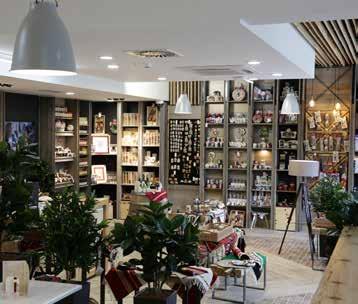
Publisher: National Tourism Organisation of Serbia Čika Ljubina 8, 11 000 Belgrade Tel.: +381 11 6557 100 Fax: +381 11 2626 767
E-mail: office@serbia.travel www.serbia.travel
For the Publisher: Marija Labović, CEO
Editor: Olgica Miljković, PhD
Text: Milena Mihaljčić
Design: Marijana Markoska, PhD
Cover design: Nikola Krdžić
Translation: Prevodilačka agencija Alkemist
Photographs: D. Bosnić, B. Jovanović, D. Vildović, S. Dingarac, S. Bibić, M. Zarić, N. Babić, R. Sazdić, V. Tatarević, M. Mitja Bogdanović, N. Kostandinović, Đ. Bošković, S. Veljović, J. Đukić, Z. Petrović, P. Lages, M. Mirčetić, S. Mićić, Z. Stanimirović, Z. Trajković, J. Živanović, B. Vučićević Vučković, N. Marić, D. Babović, I. Čučković, M. Cvetković, E. Pešić, Narodni muzej Beograd, Muzej naivne i marginalne umetnosti, Jagodina, Galerija Mića Popović, Loznica, Galerija Milena Pavlović Barilli, Požarevac (V. Marković), TO Novi Pazar, Exit photo team, Hiishii, Hotel Izvor, Delegacija EU u Srbiji, Agencija Valjevac, Arhiva TO Zlatibor, Arhiva TO Vrnjačka Banja, Arhiva JP “Smederevska tvrđava”, Arhiva Tvrđava Golubački grad, Arhiva TOO Kladovo, Arhiva TO Negotin, Arhiva TO Boljevac, TO Sokobanja, Arhiva TO Niš, Arhiva Aqua Park Petroland, Luka Šarac, Miloš Karaklić, Miloš Milenković.
Mapping board: “Merkur – SV”, Belgrade Printed by: Futura, Novi Sad, 2022 Fifth edition in English, 2022
Copies: 2,000 ISBN 978-86-6005-632-2 034-01-01-63/202022

338.48(497.11)(036)
MIHALJČIĆ, Milena, 1957[Fifty two weekends]

Weekends in Serbia / [text Milena Mihaljčić ; photo graphs D. Bosnić ... et al.]. - 3rd
